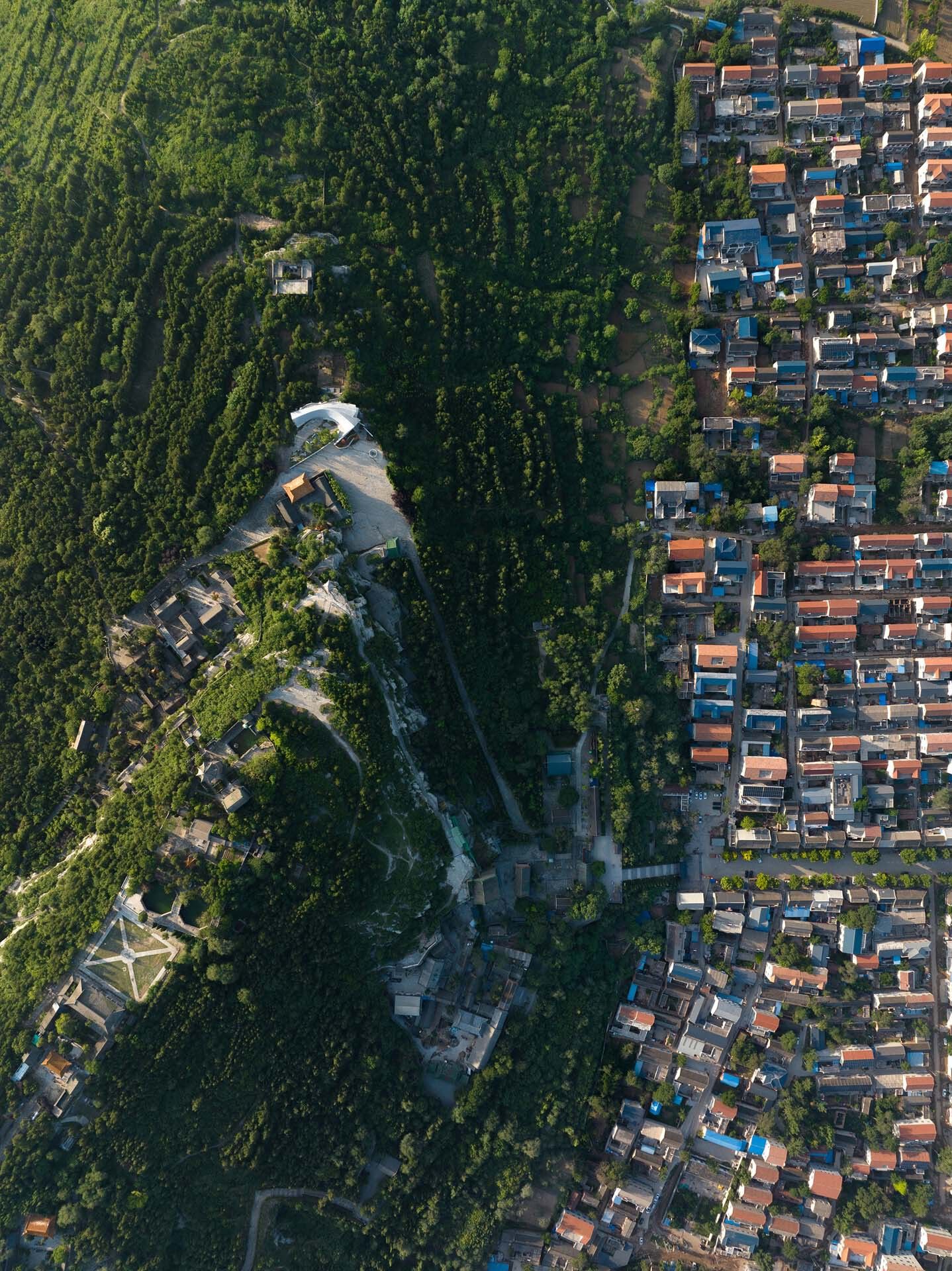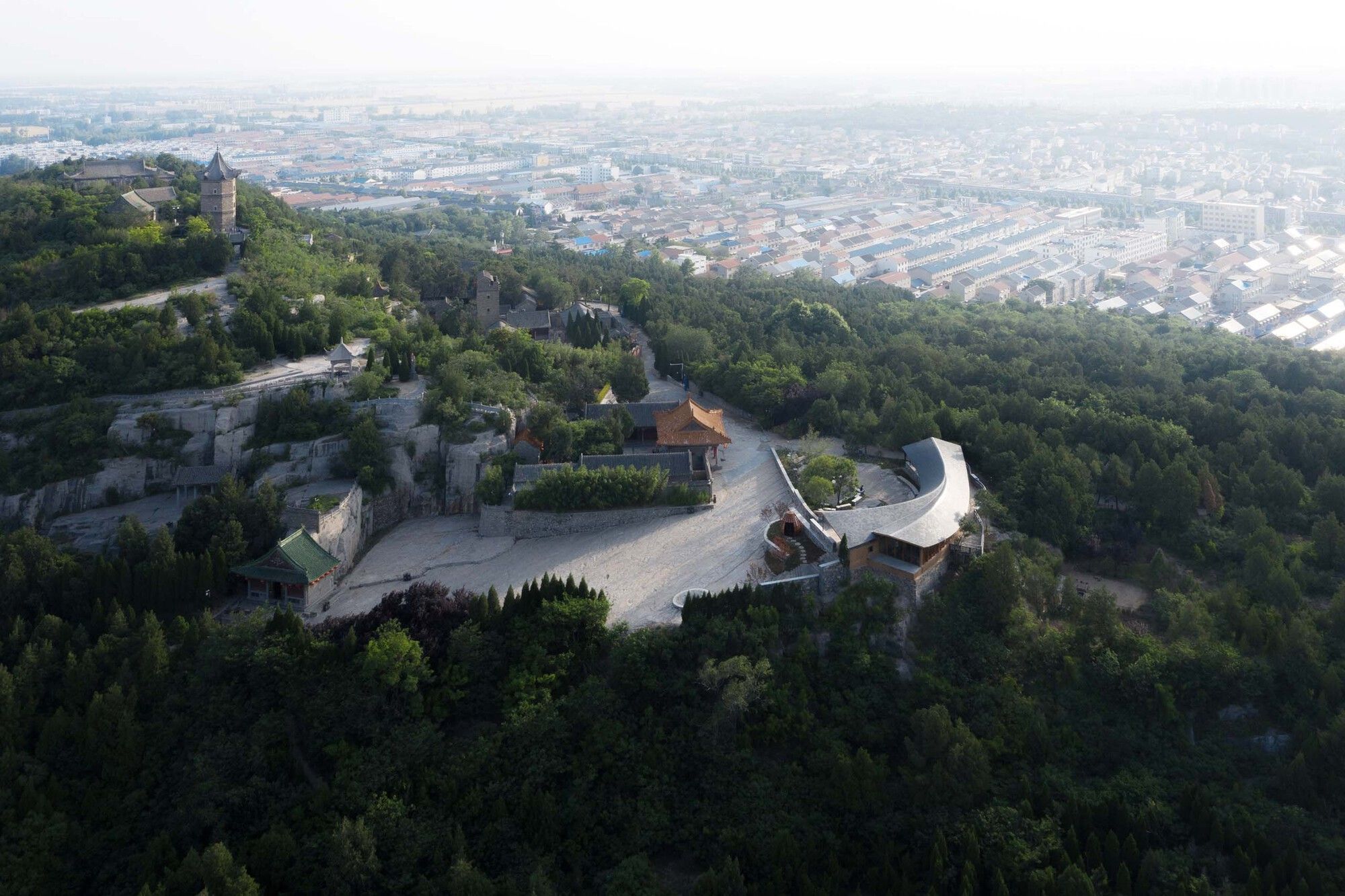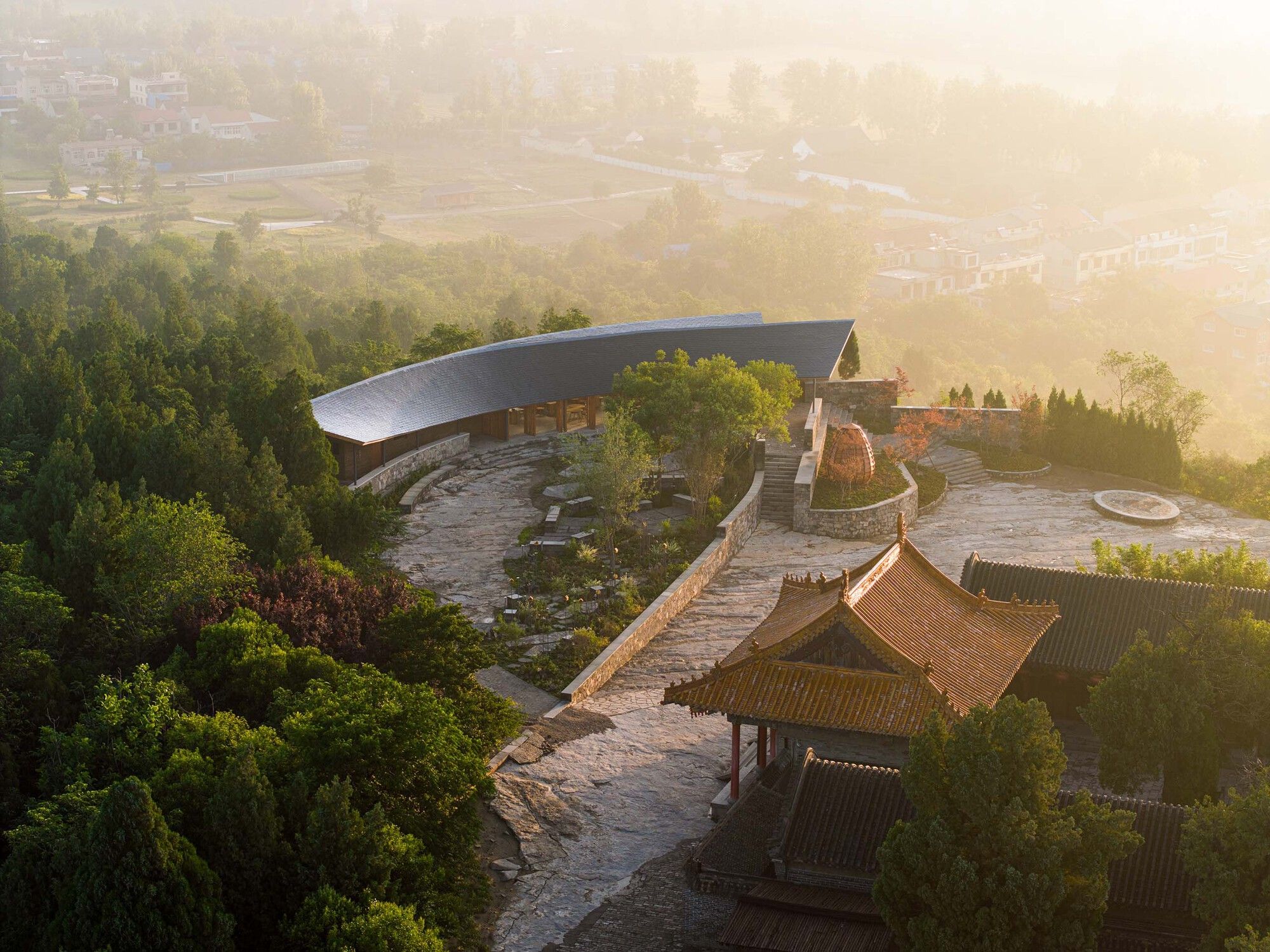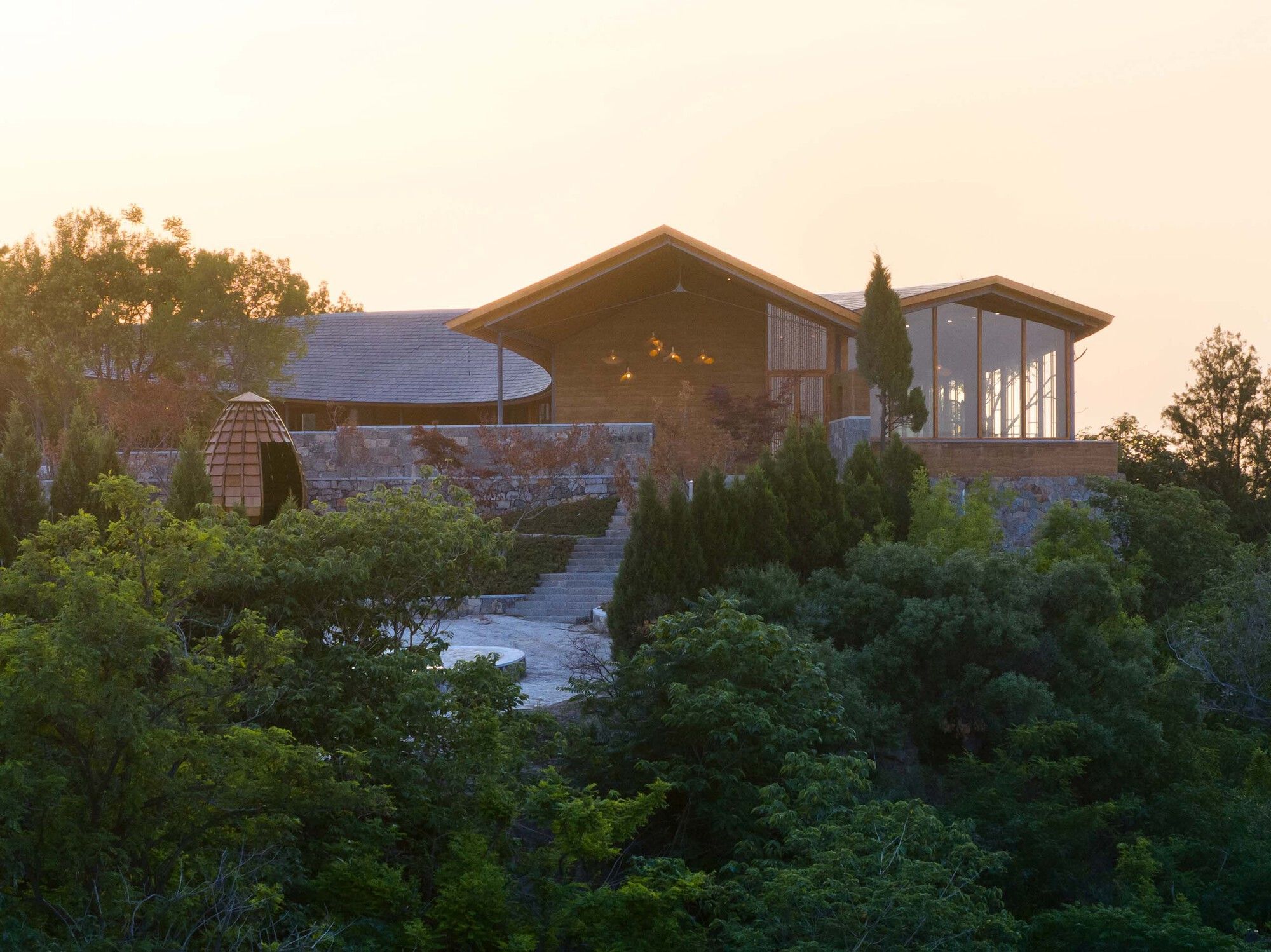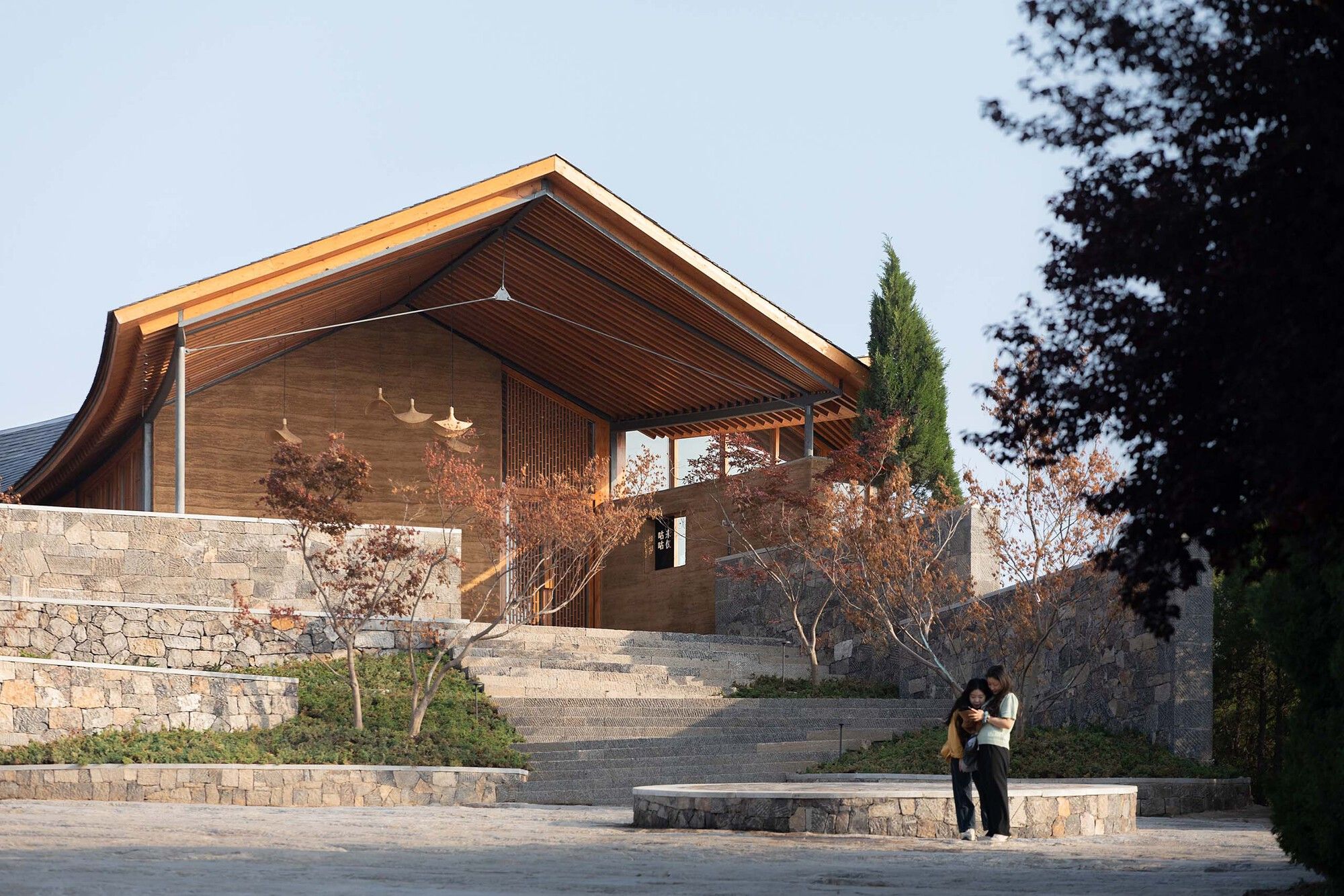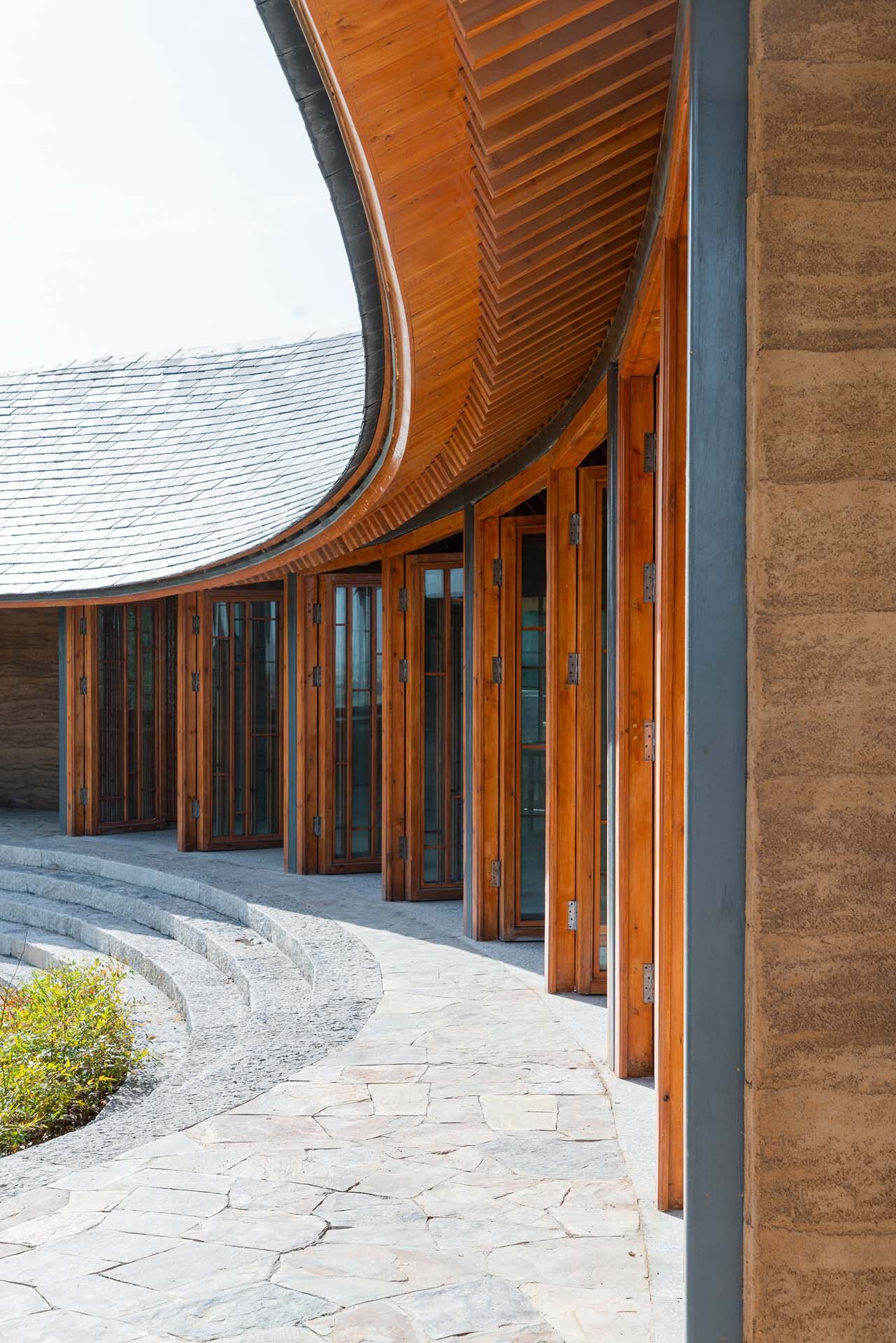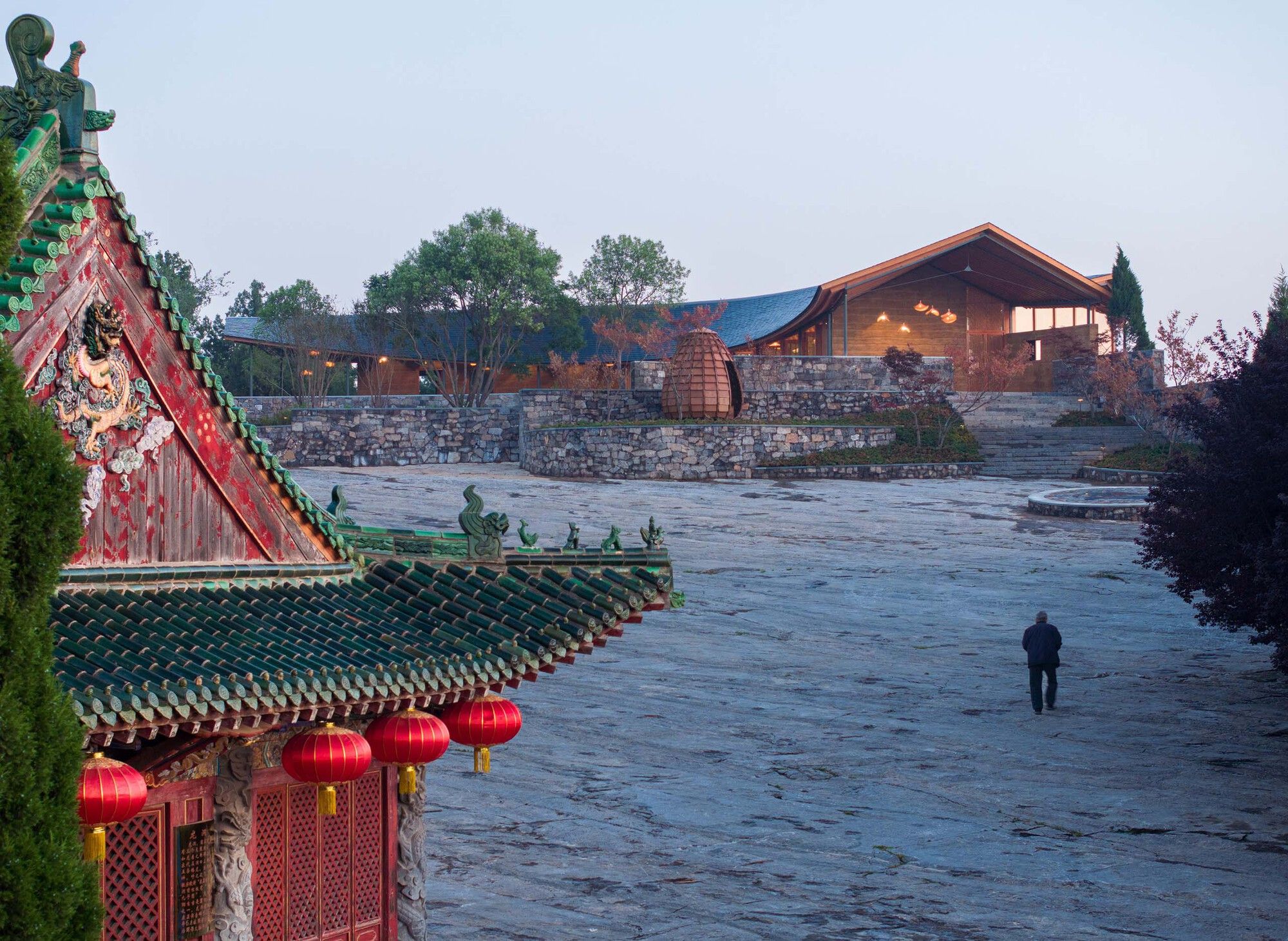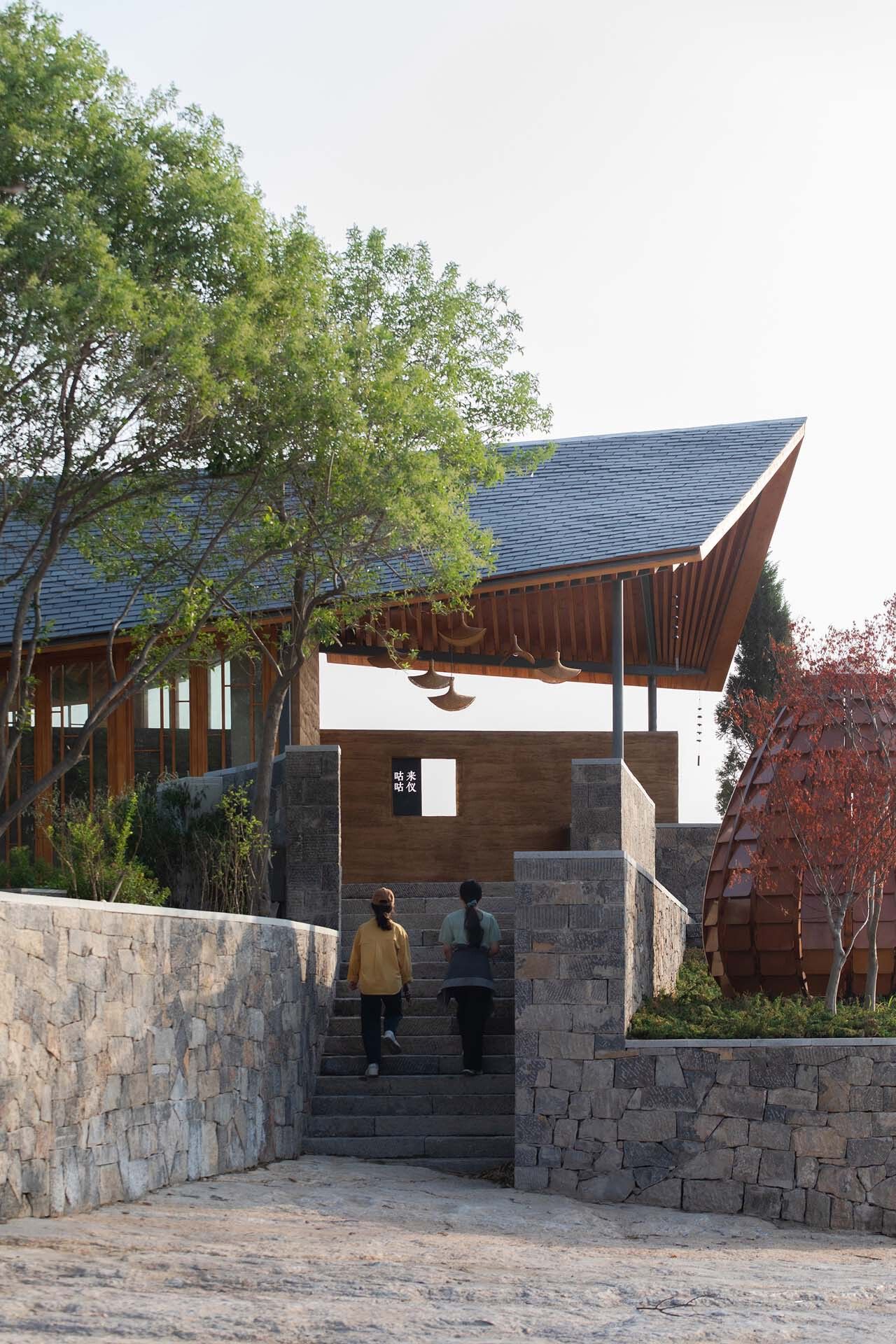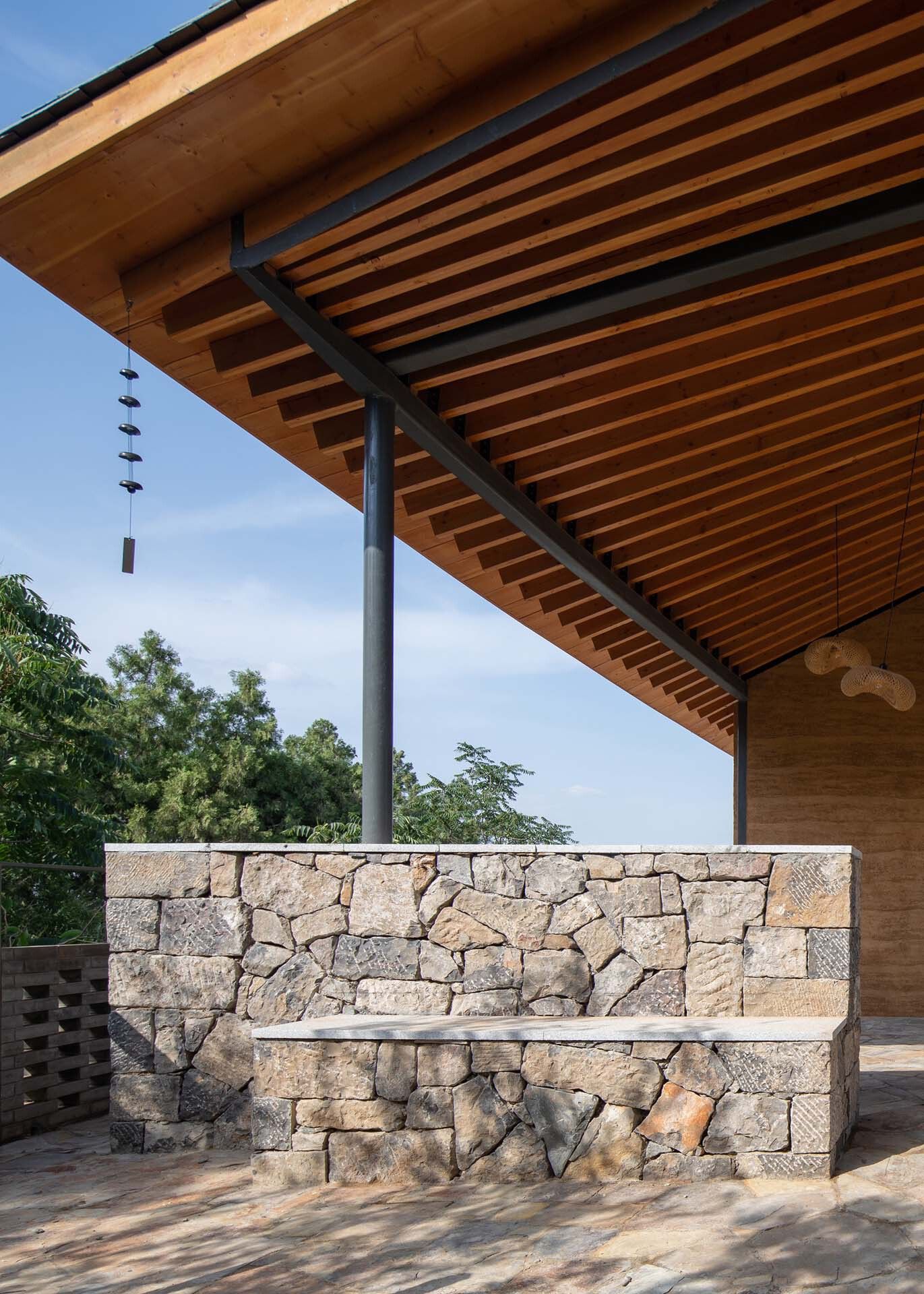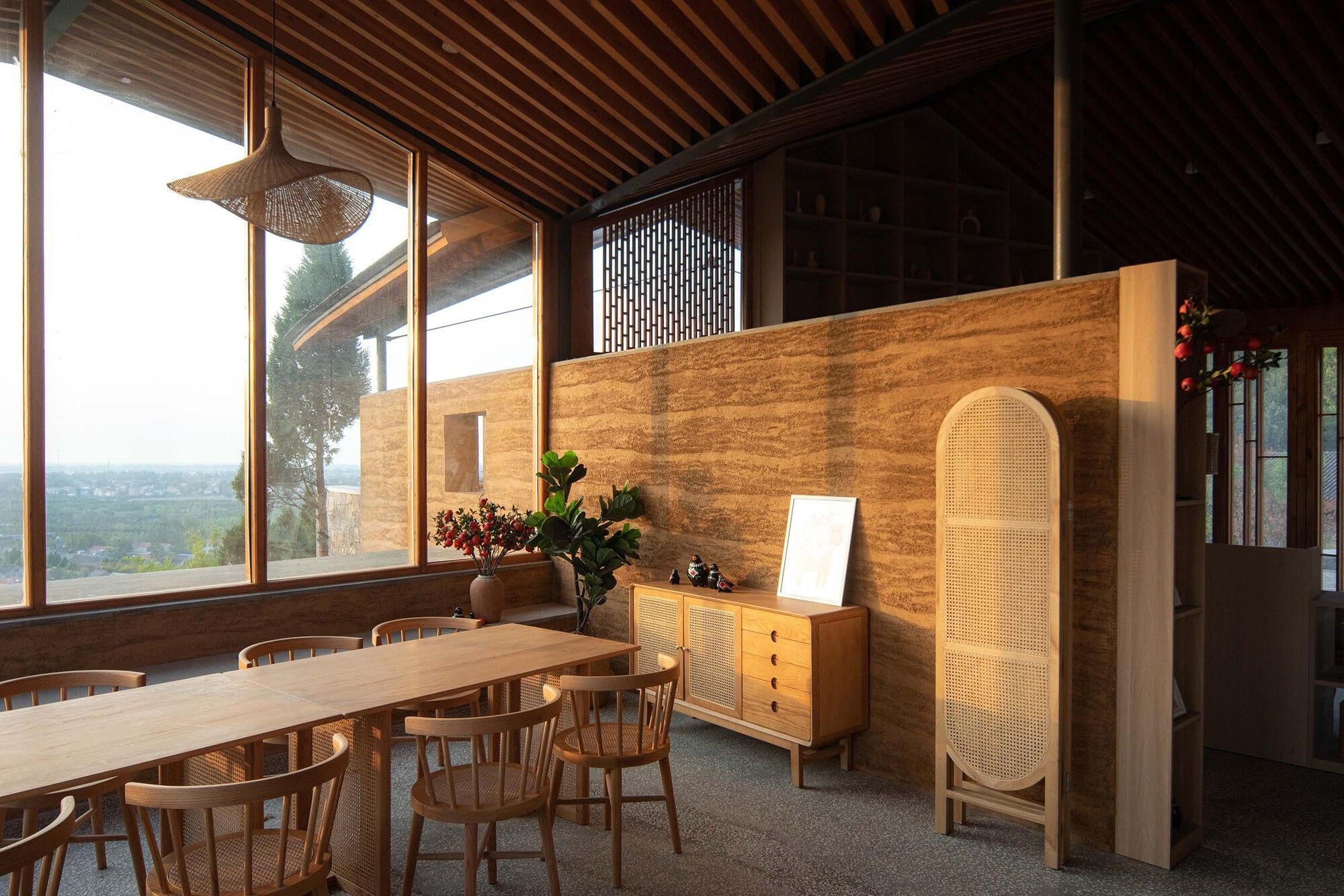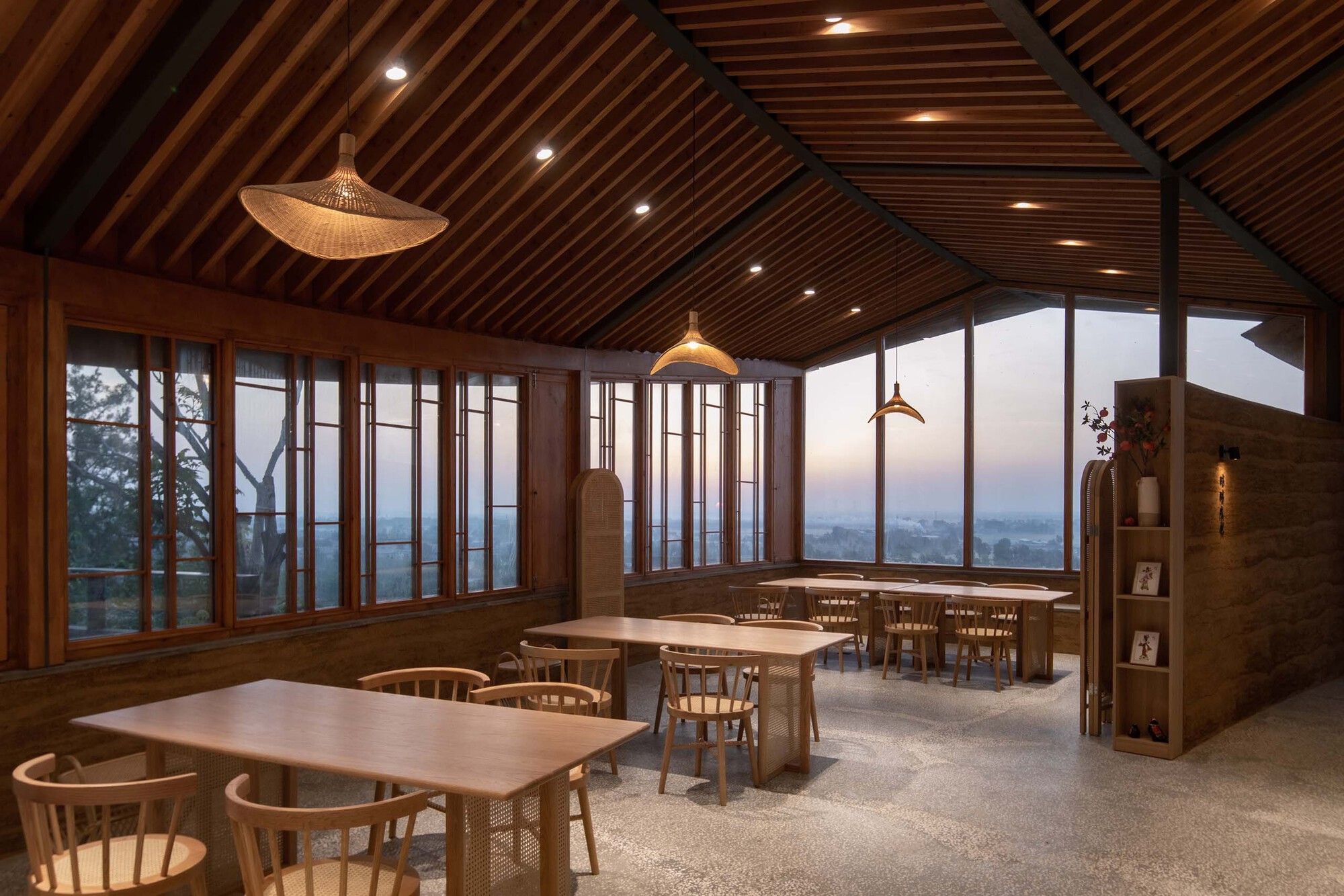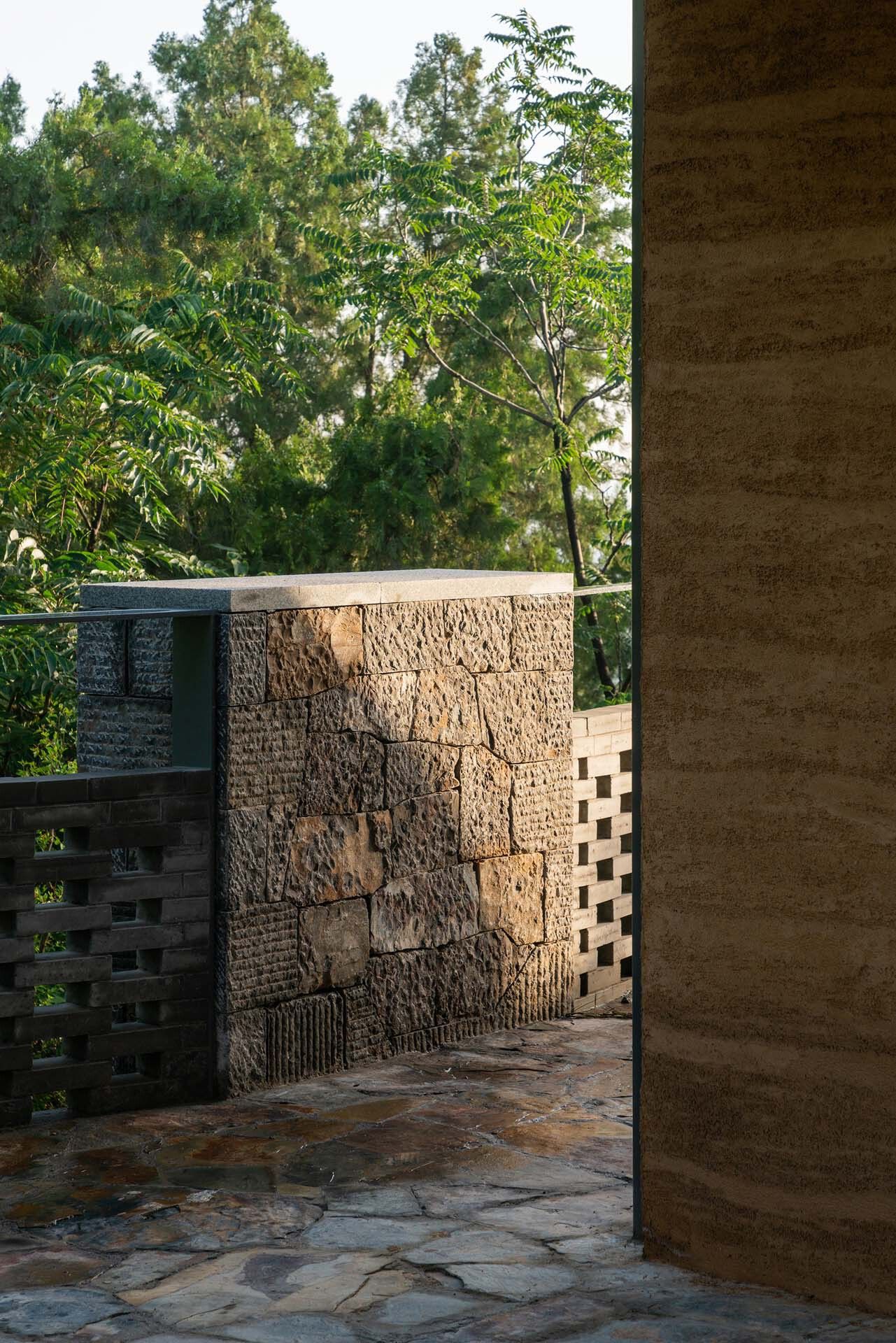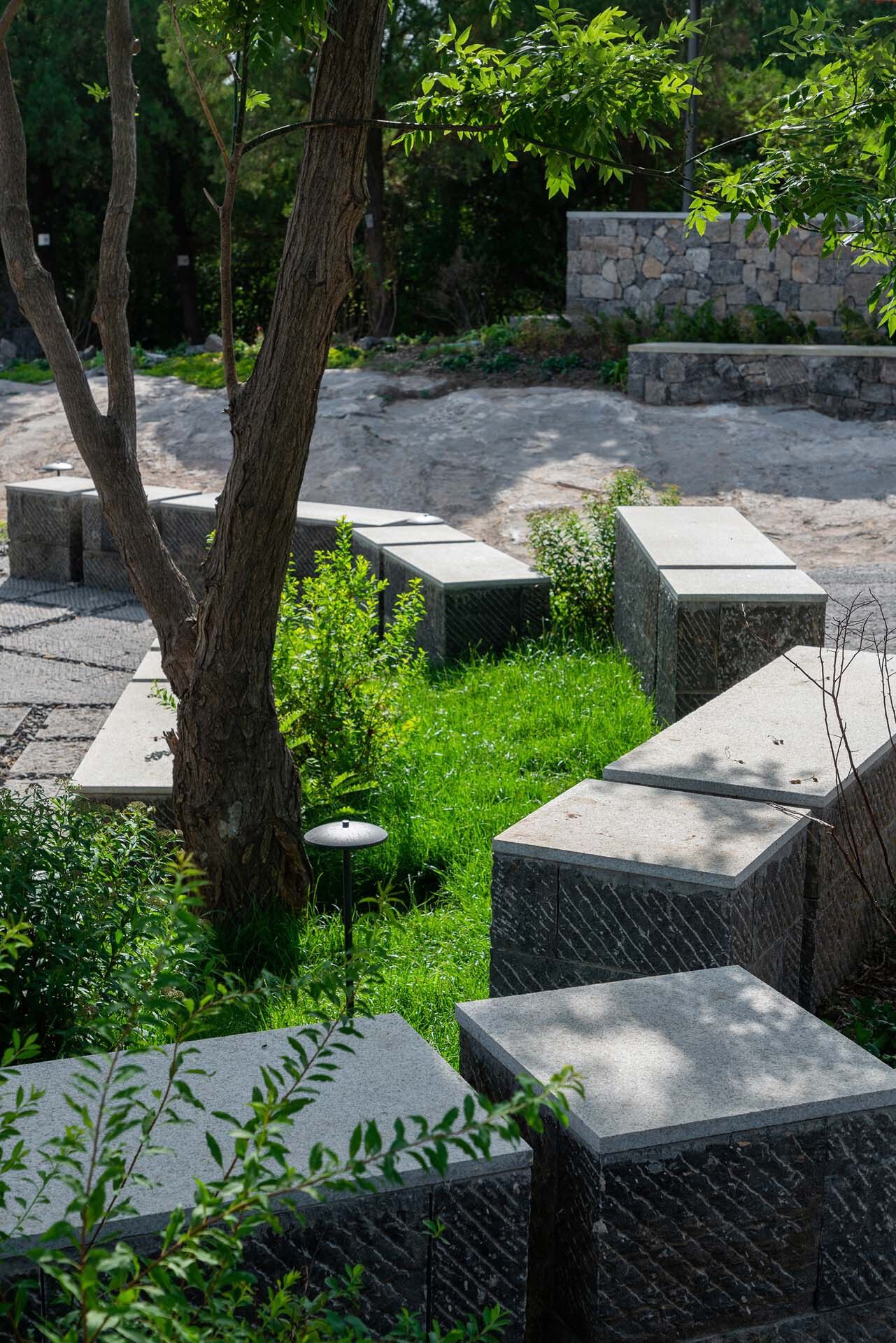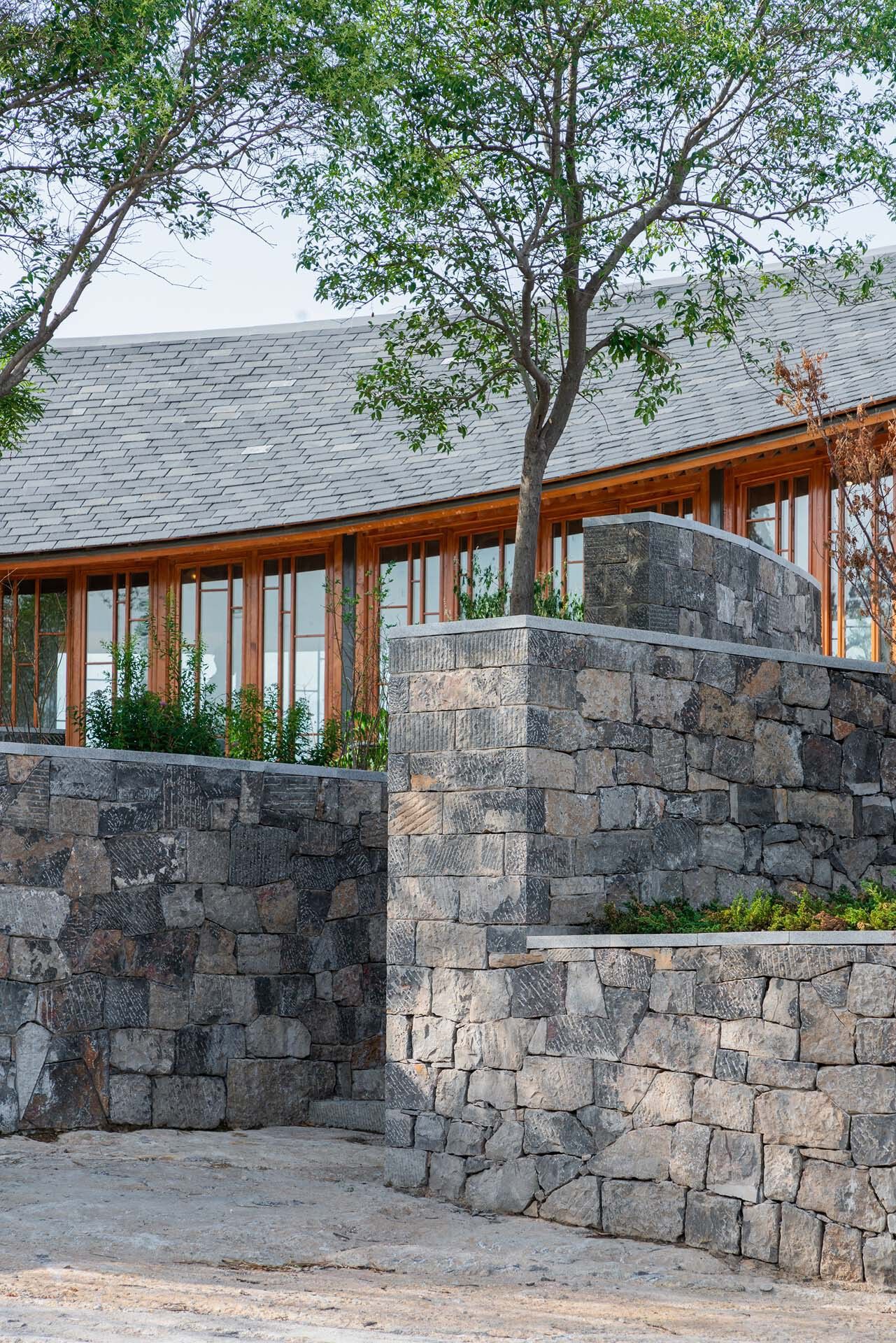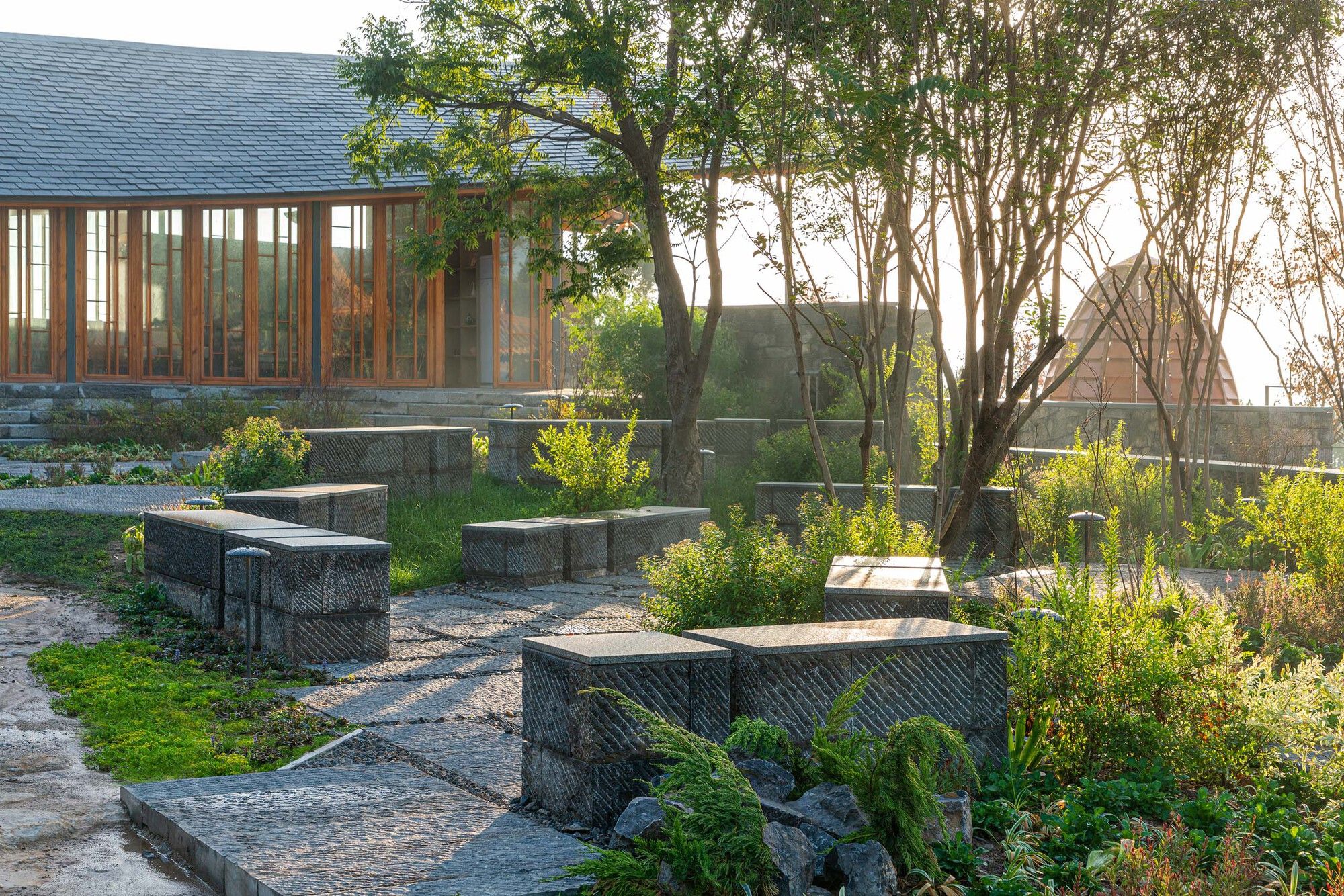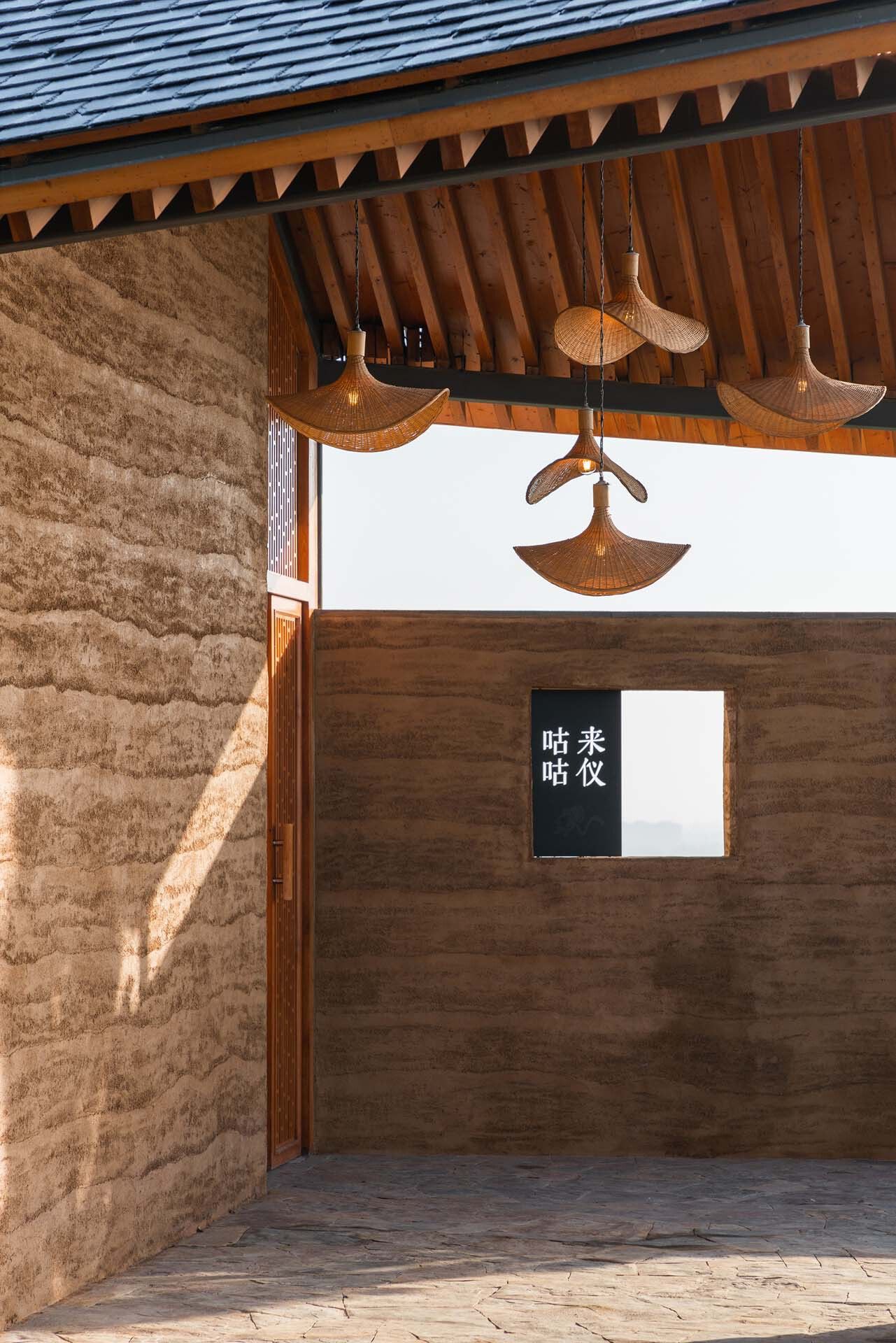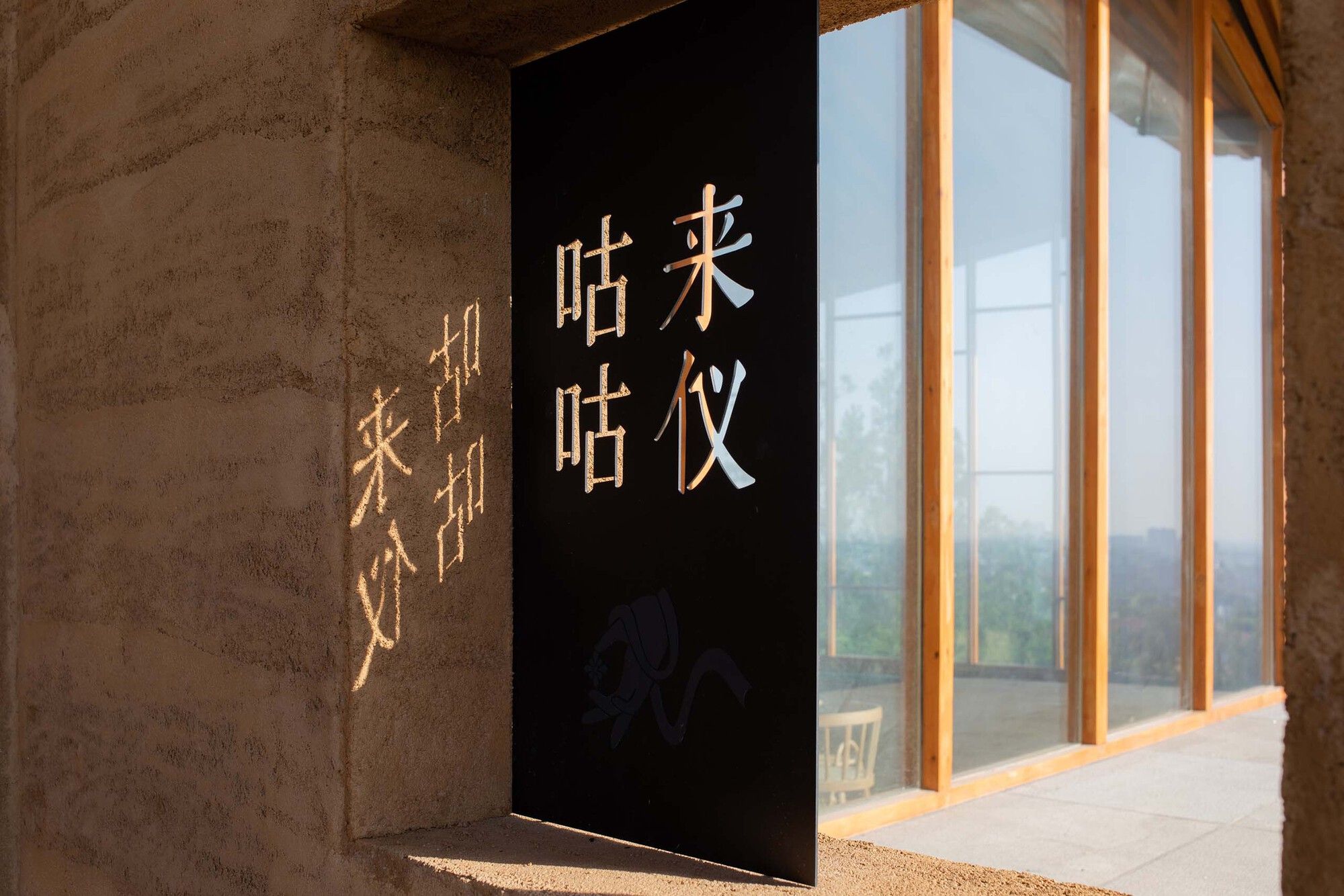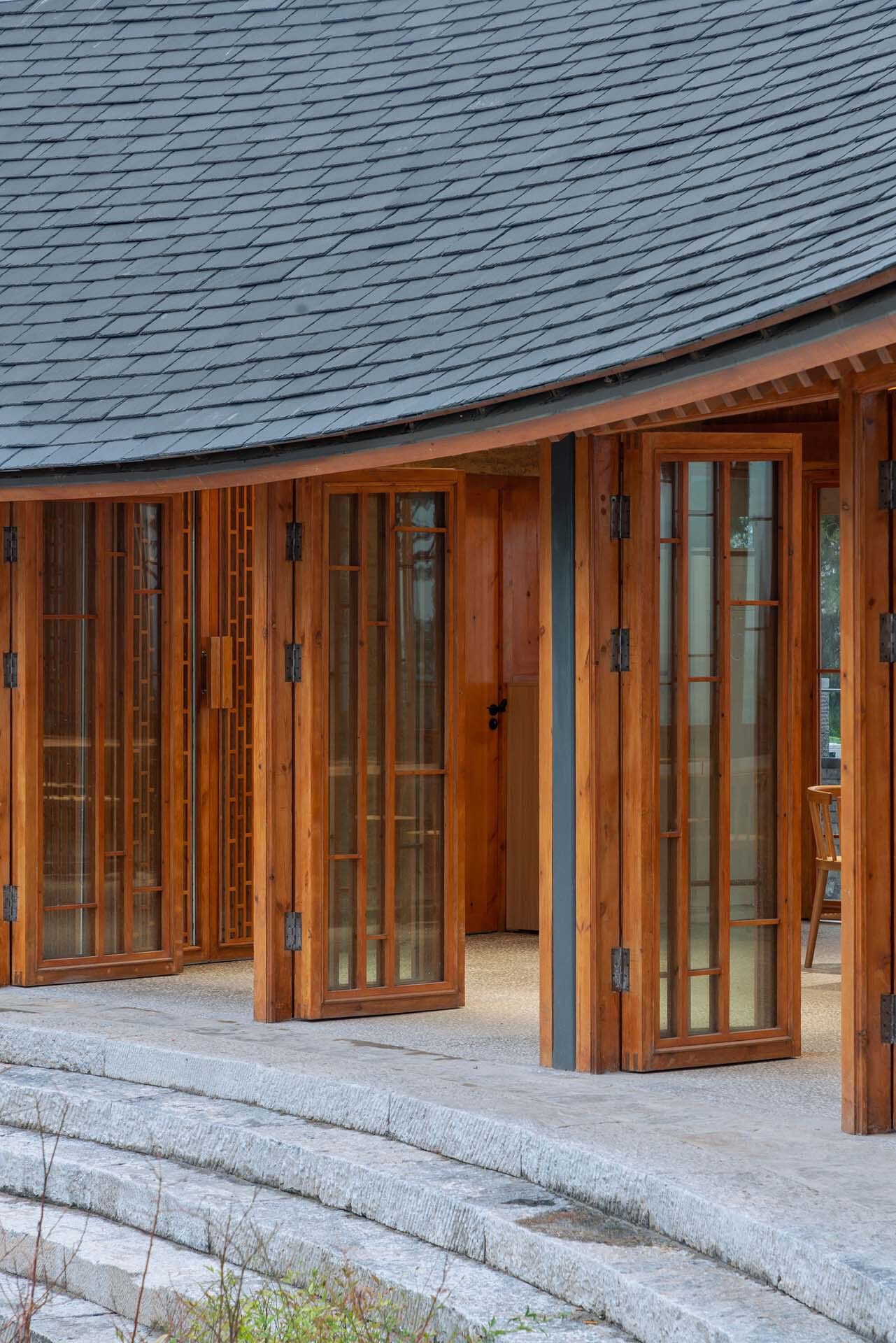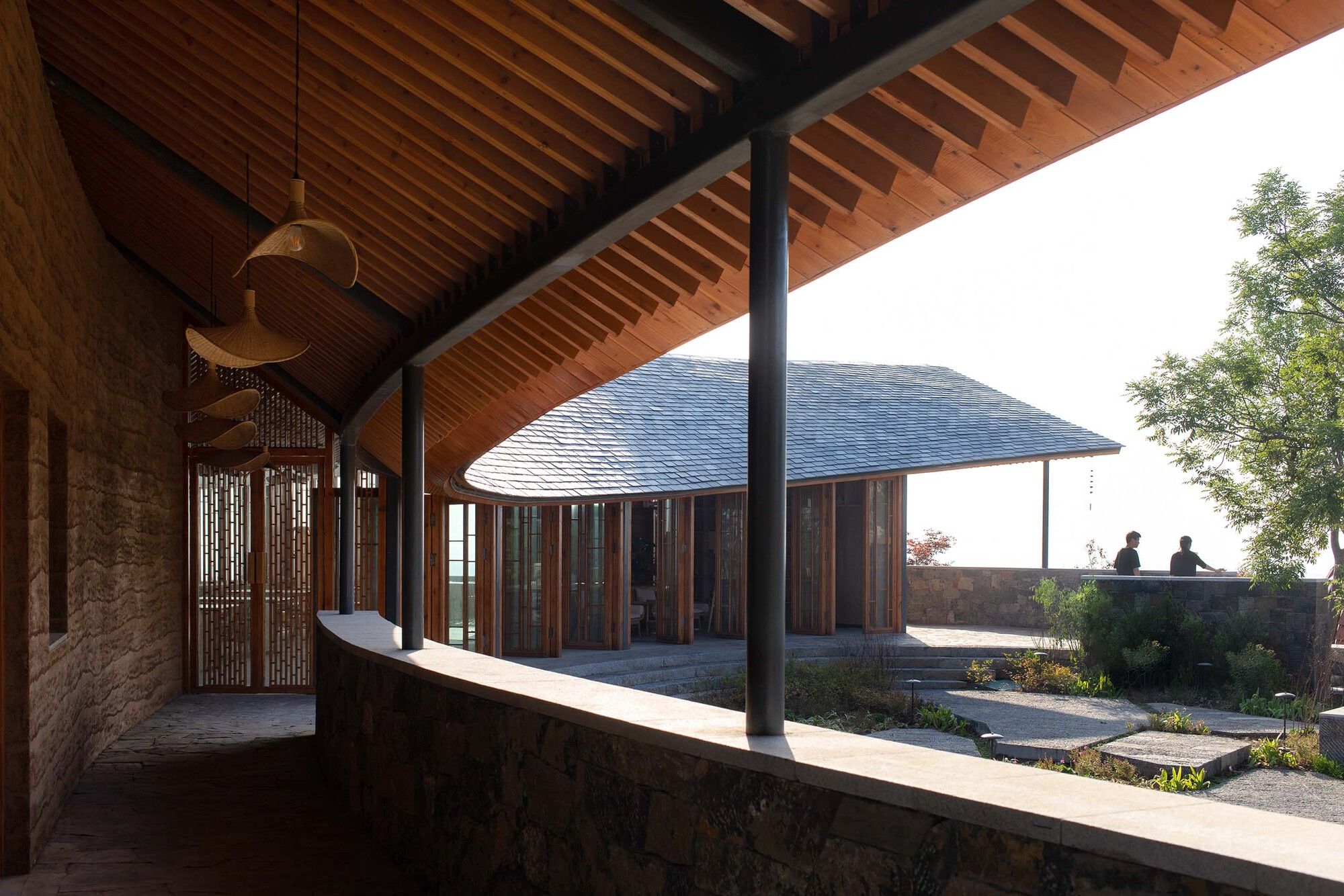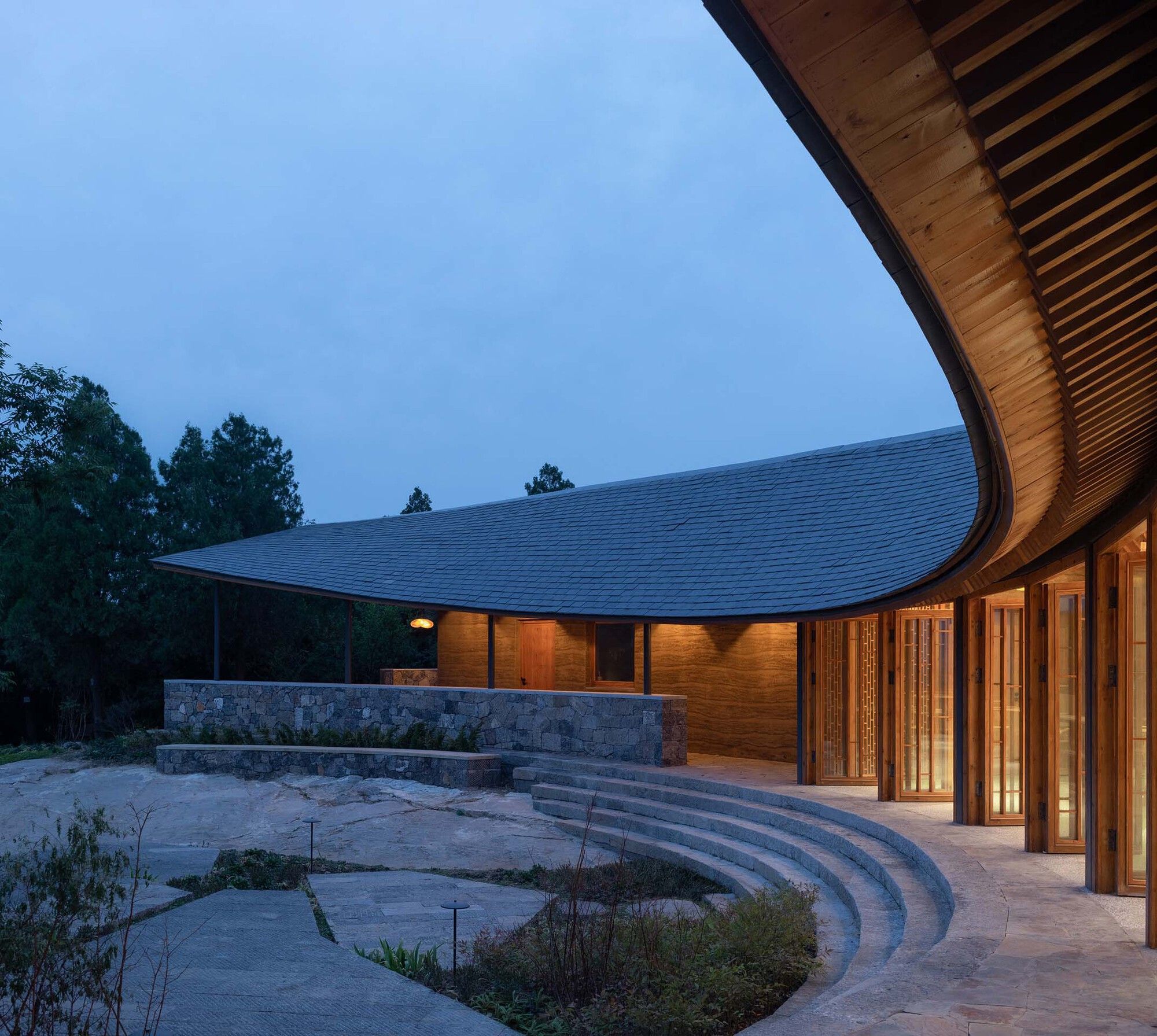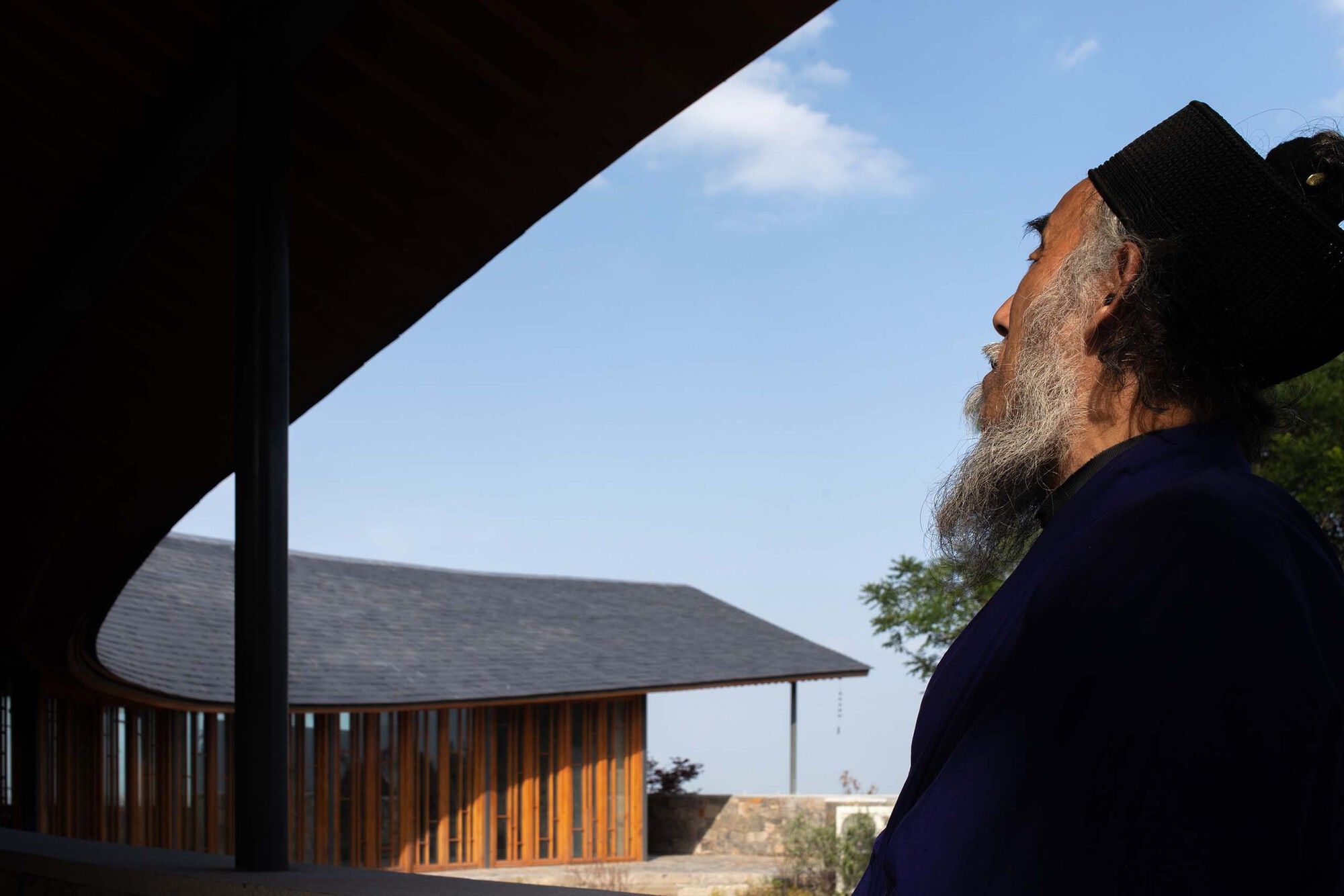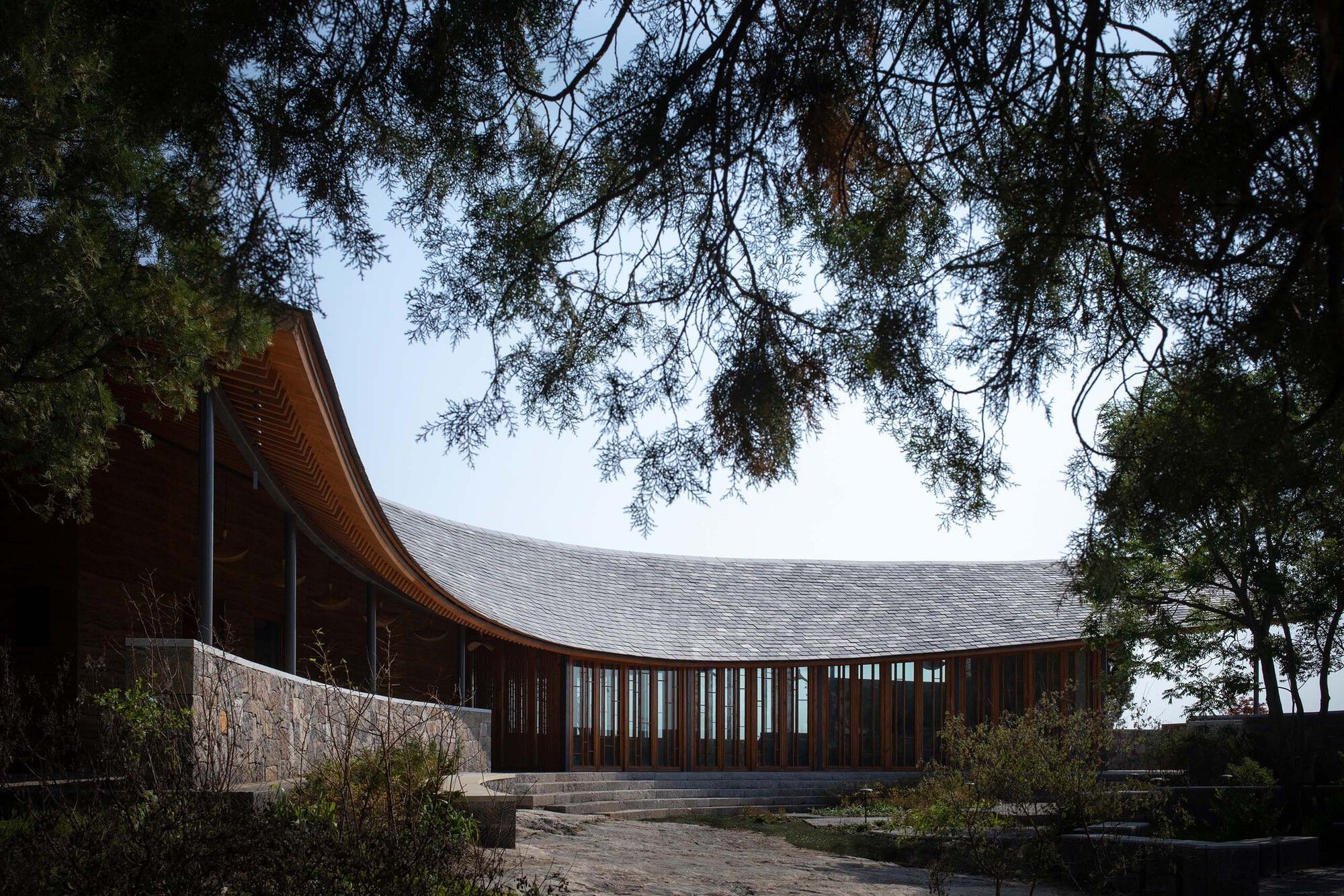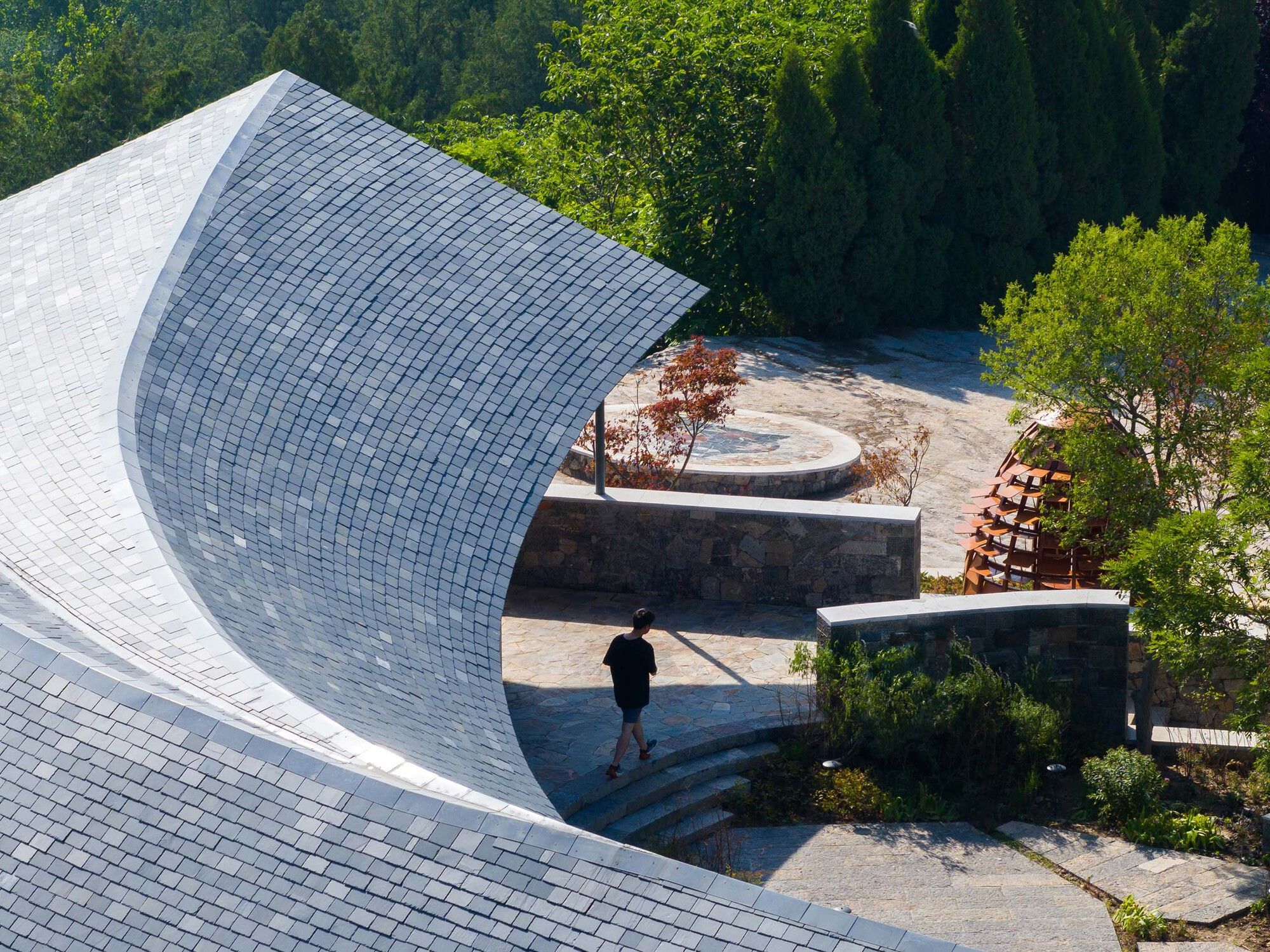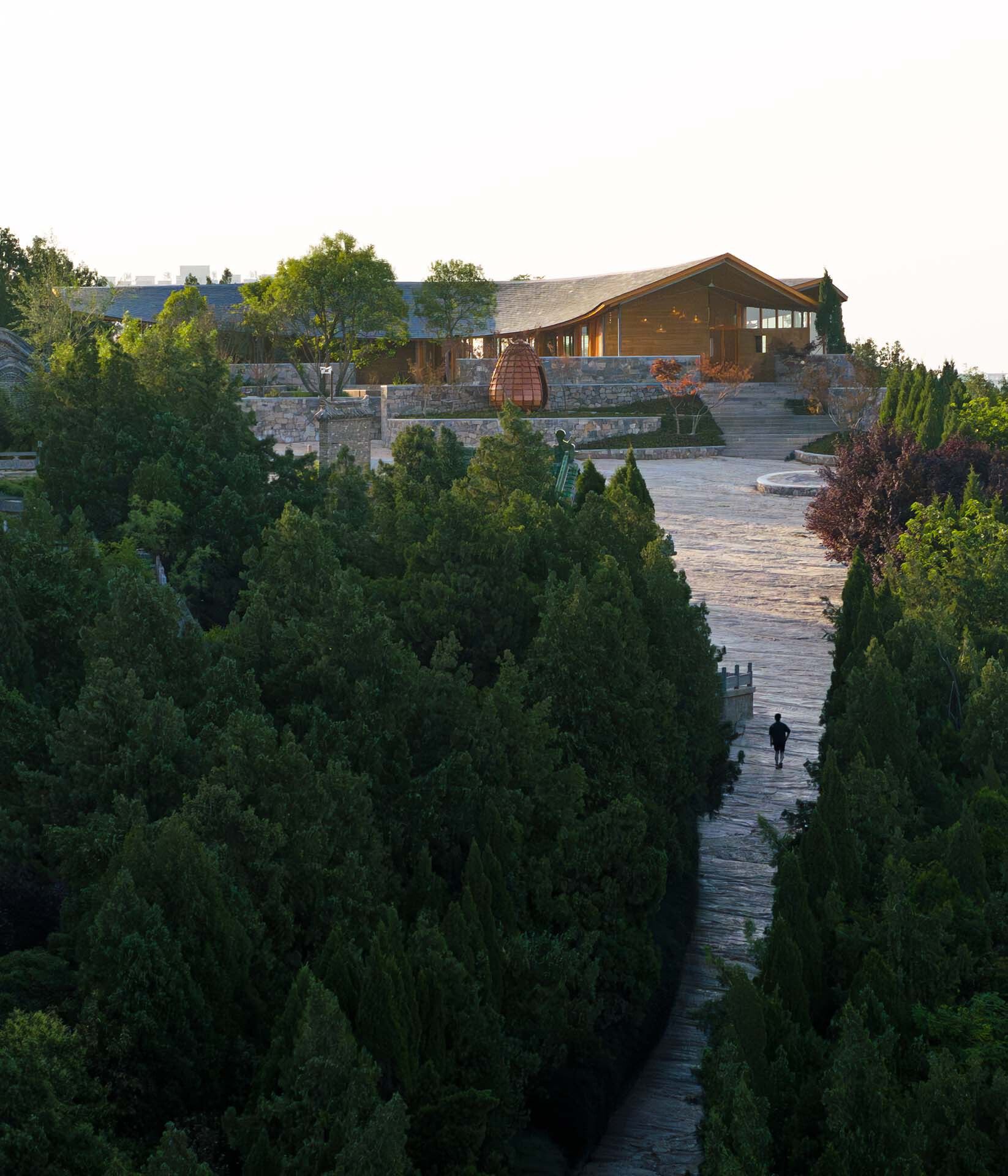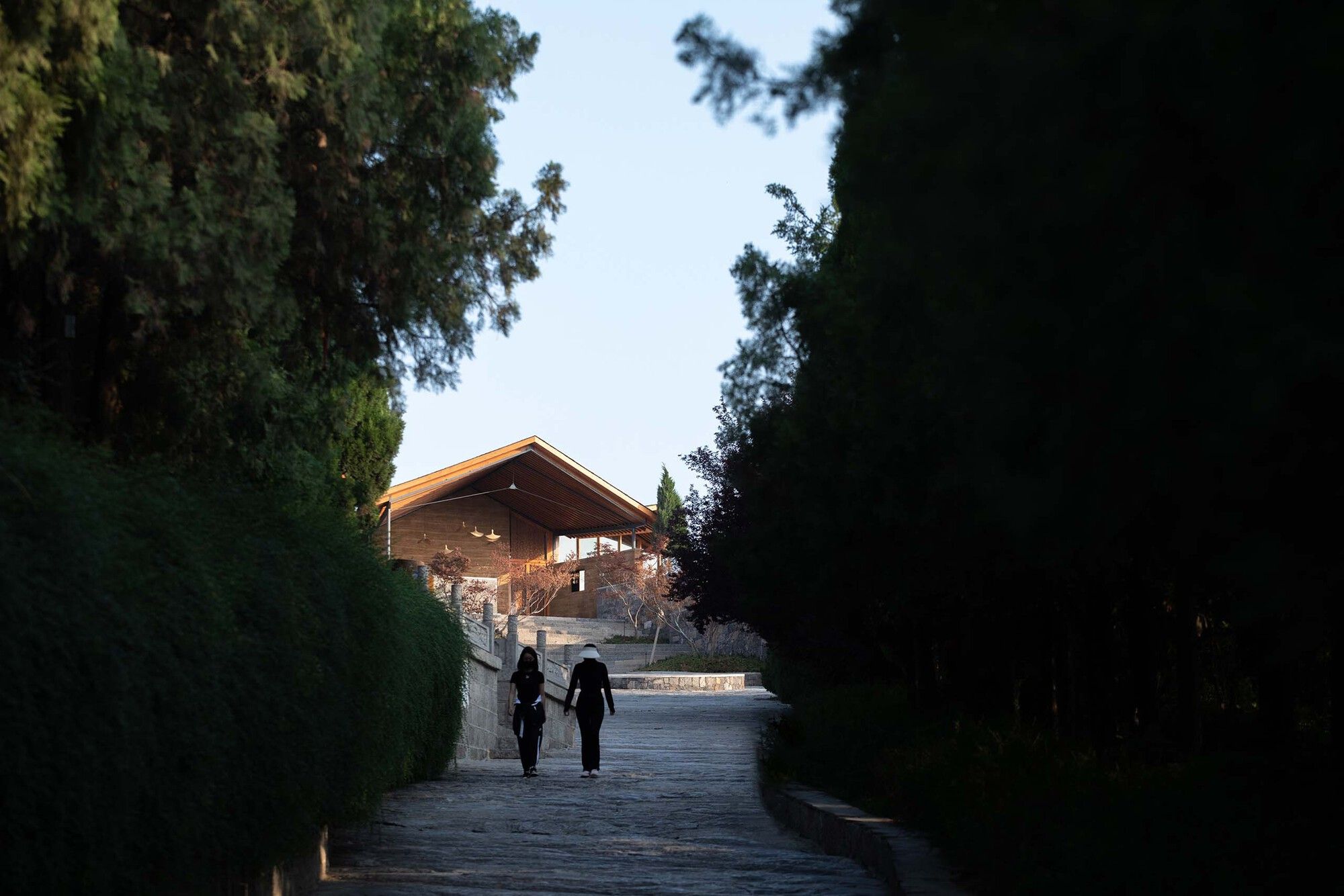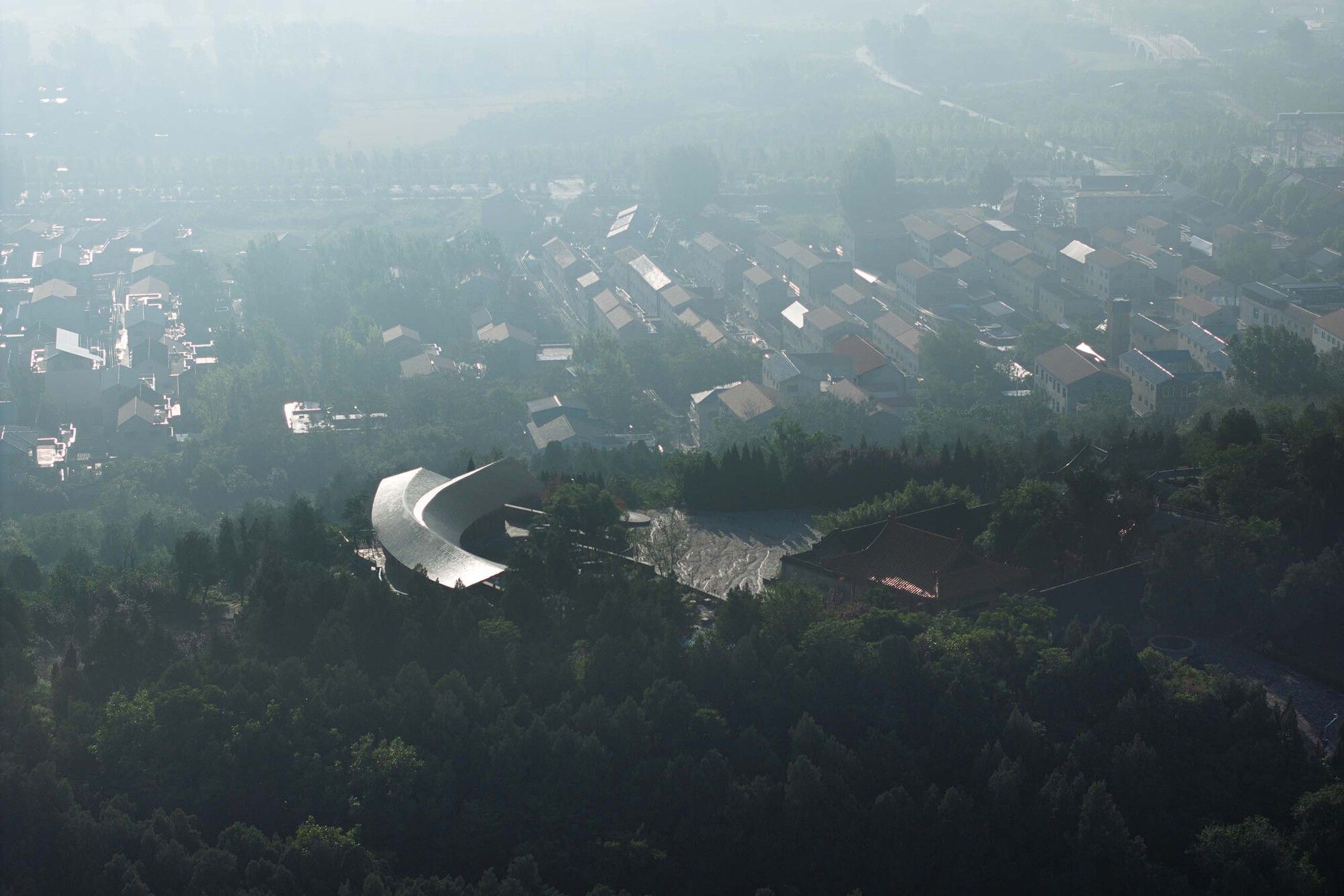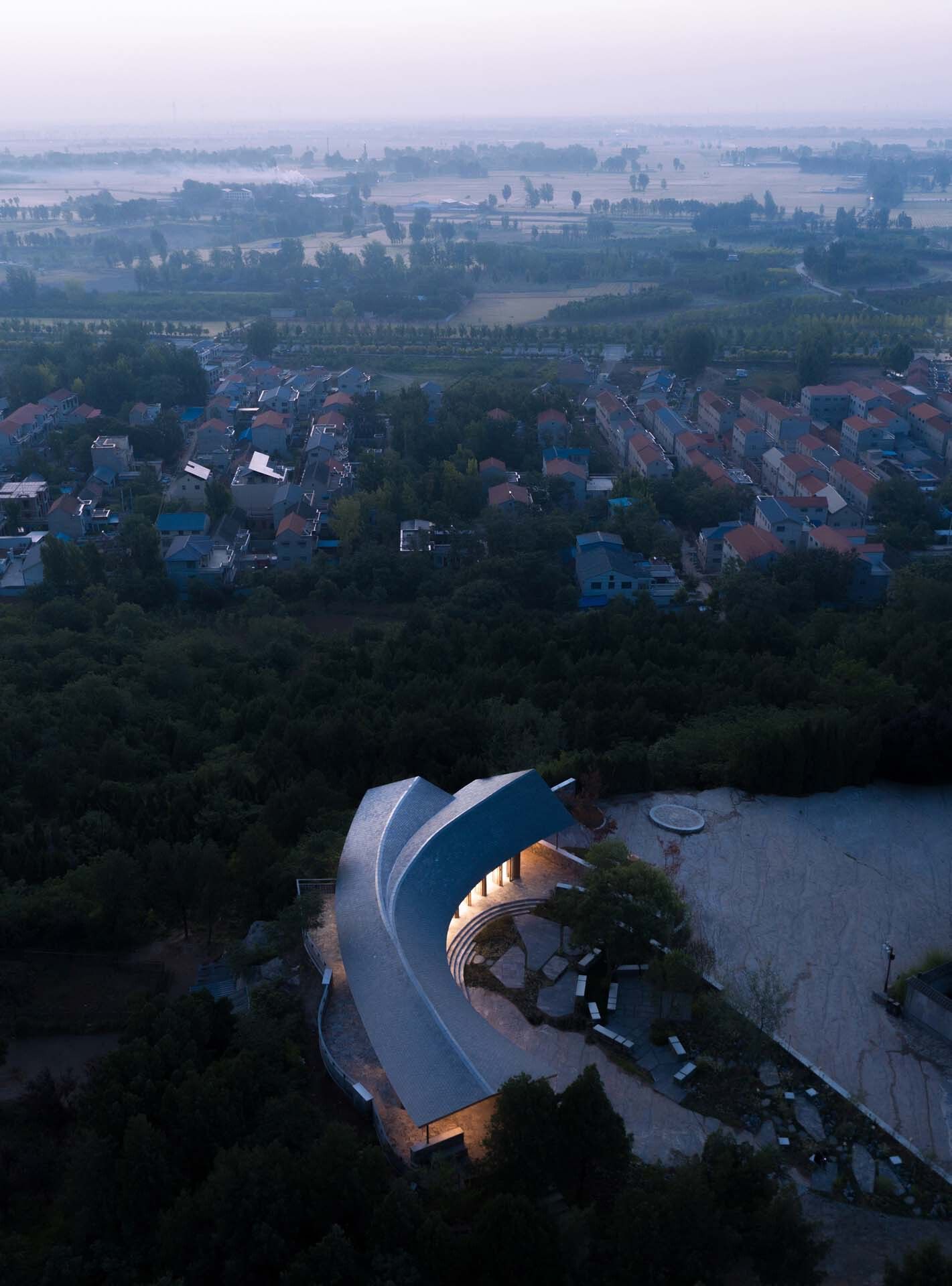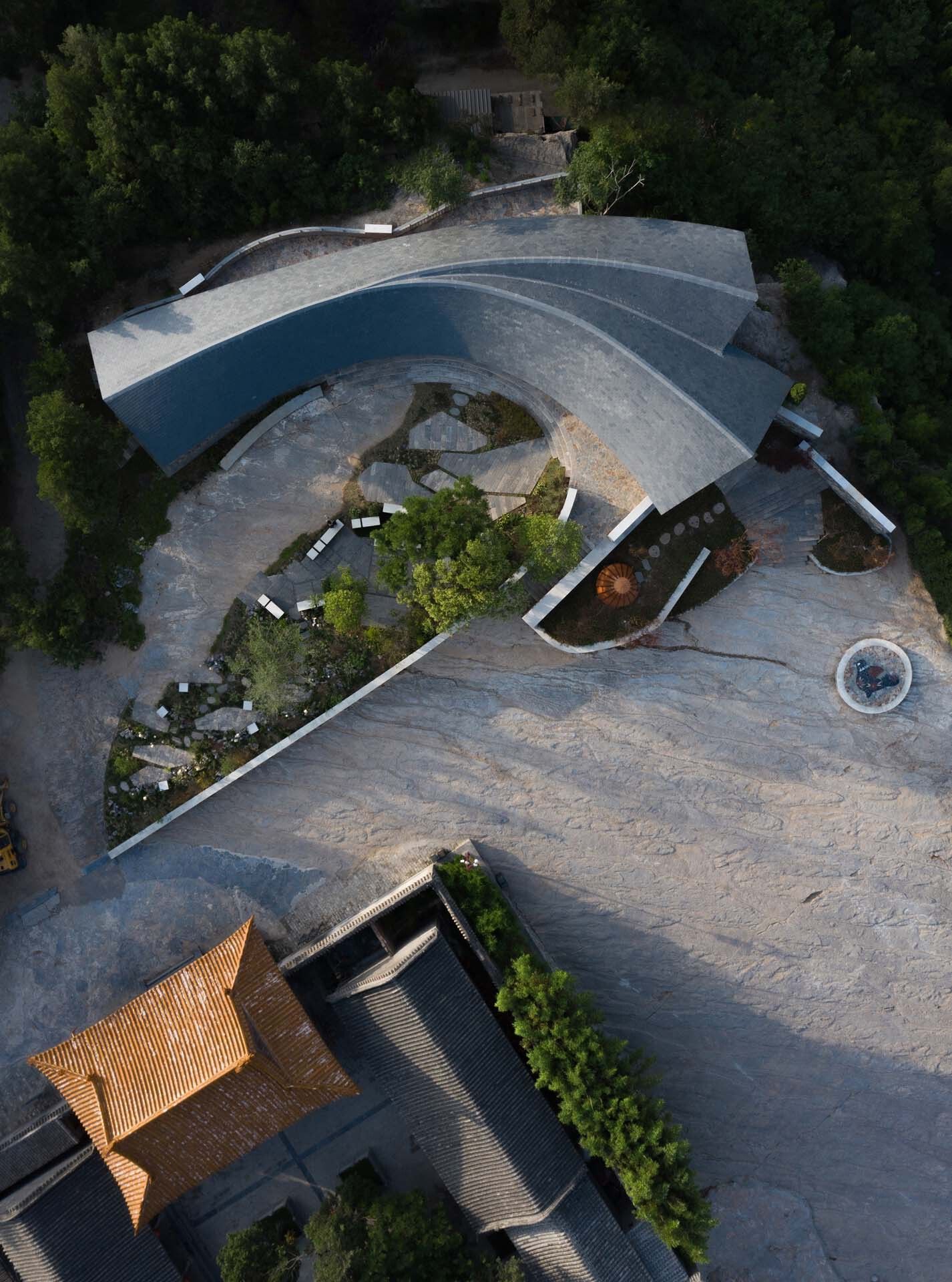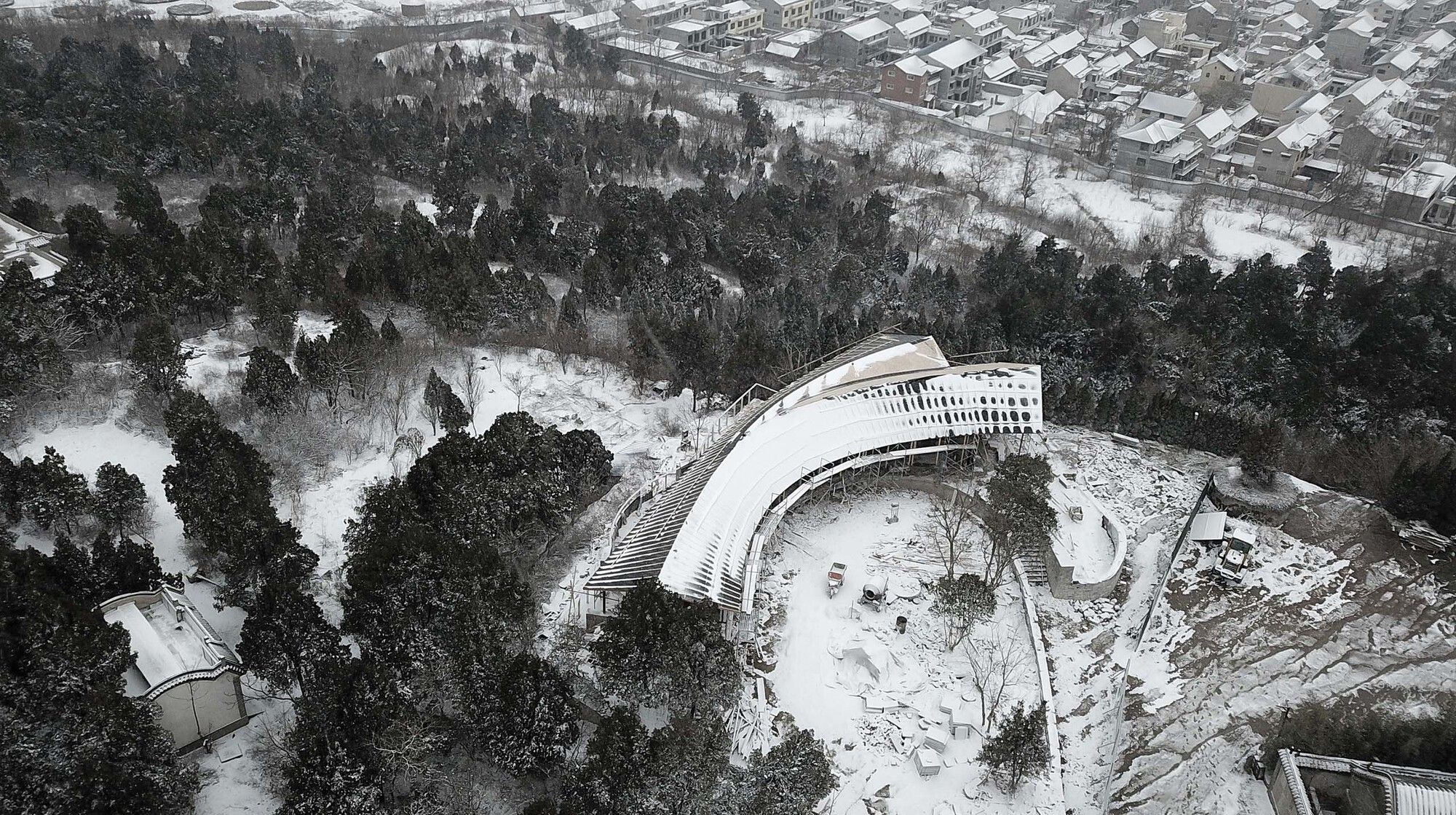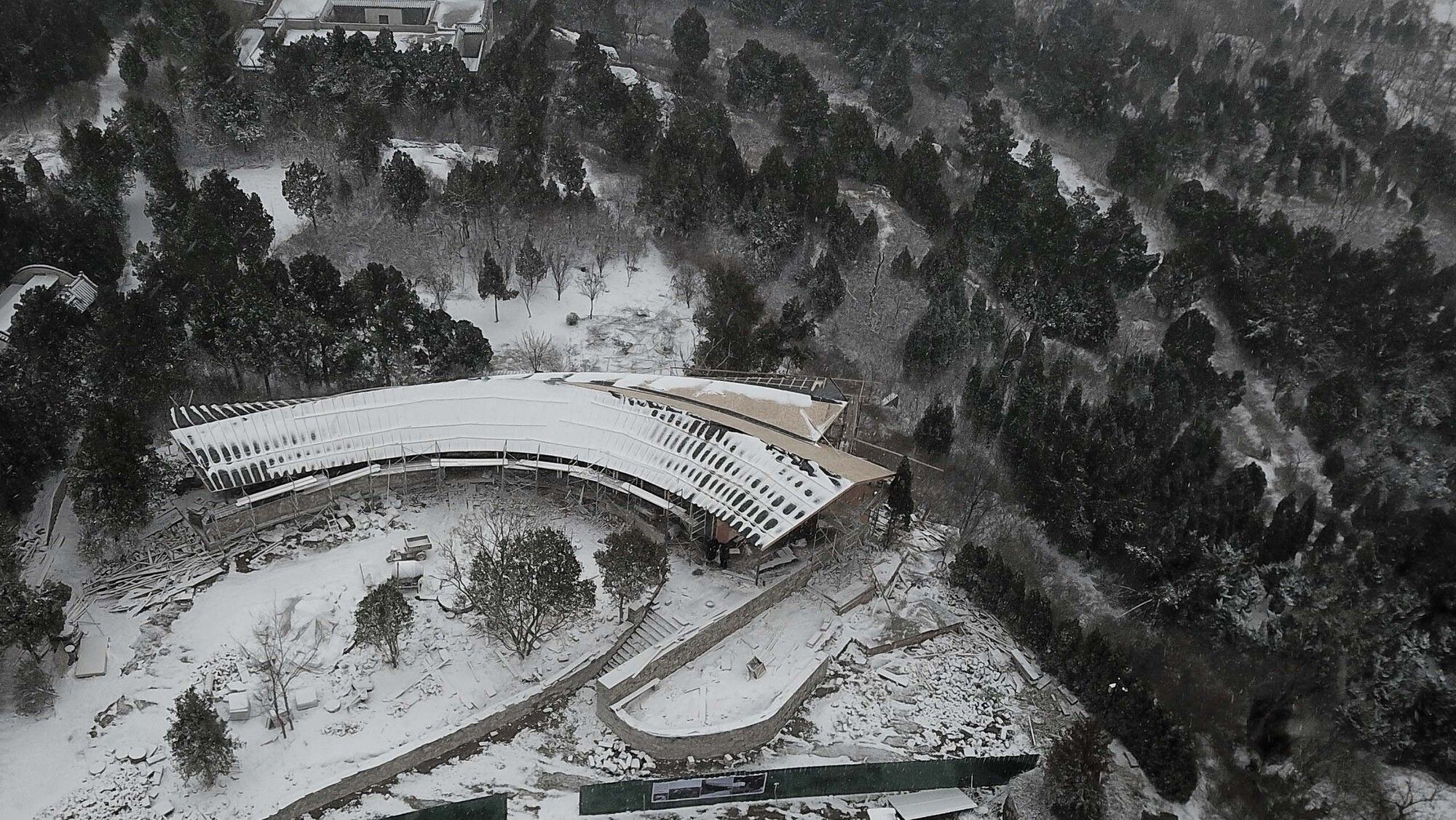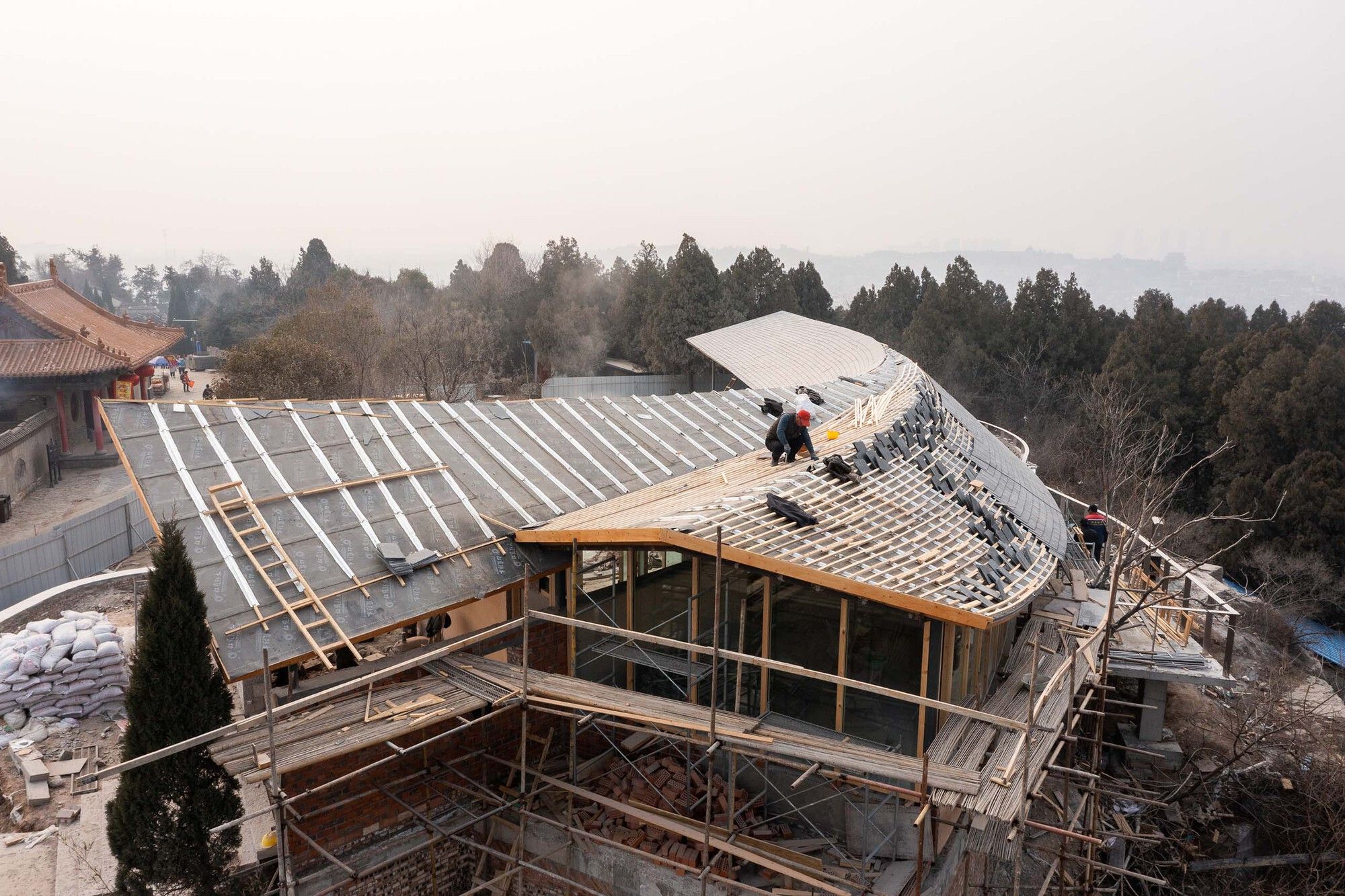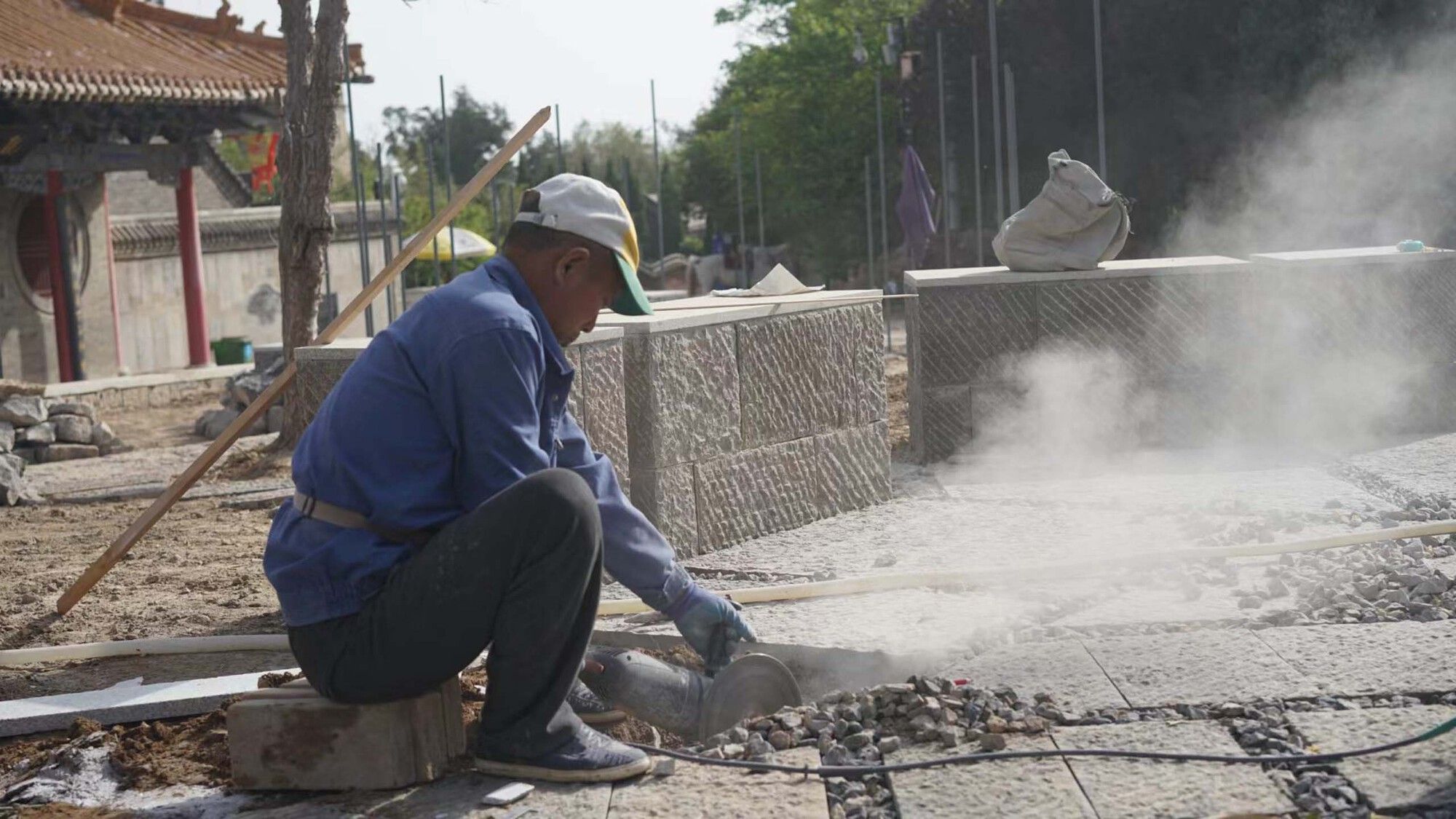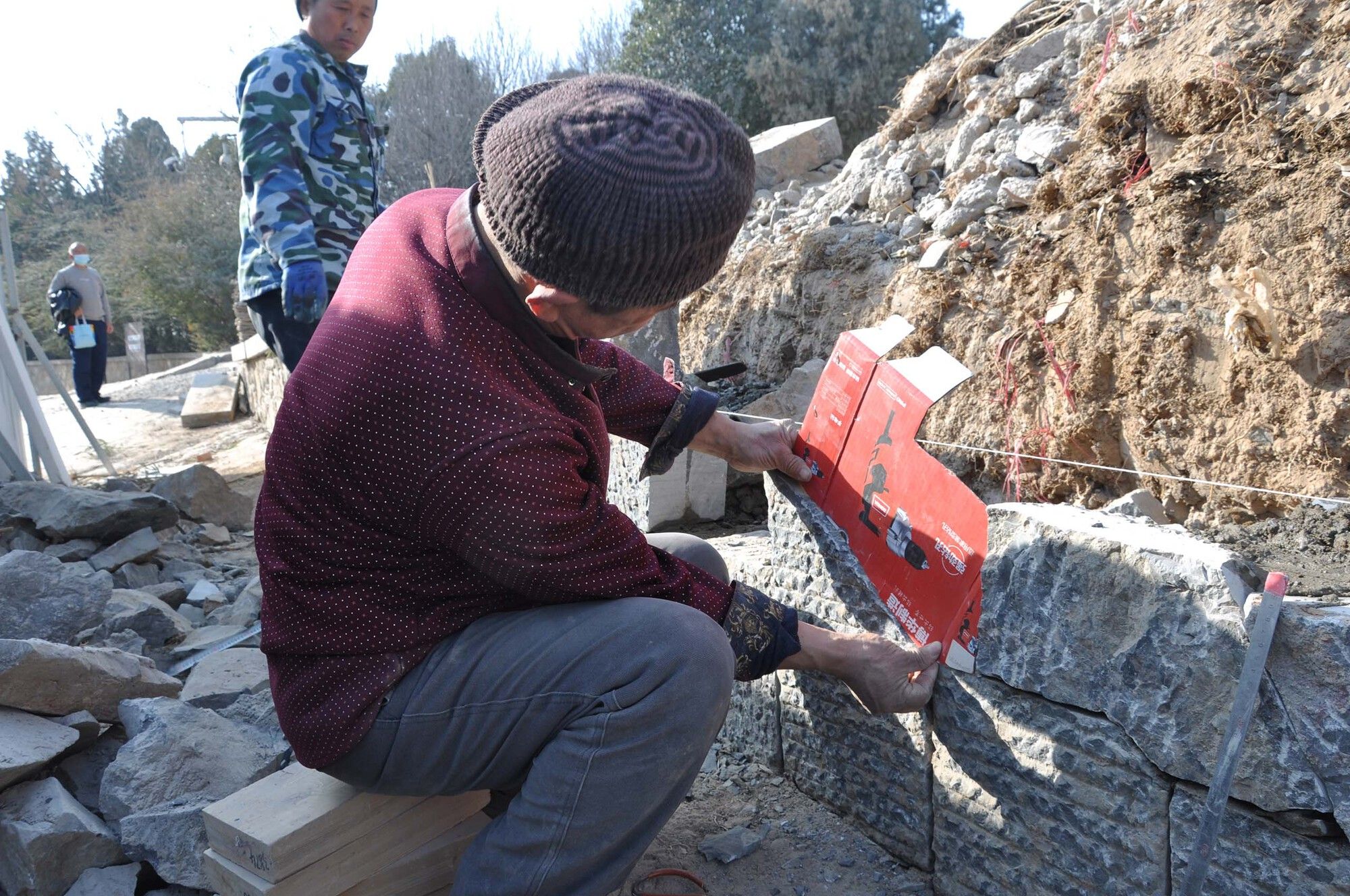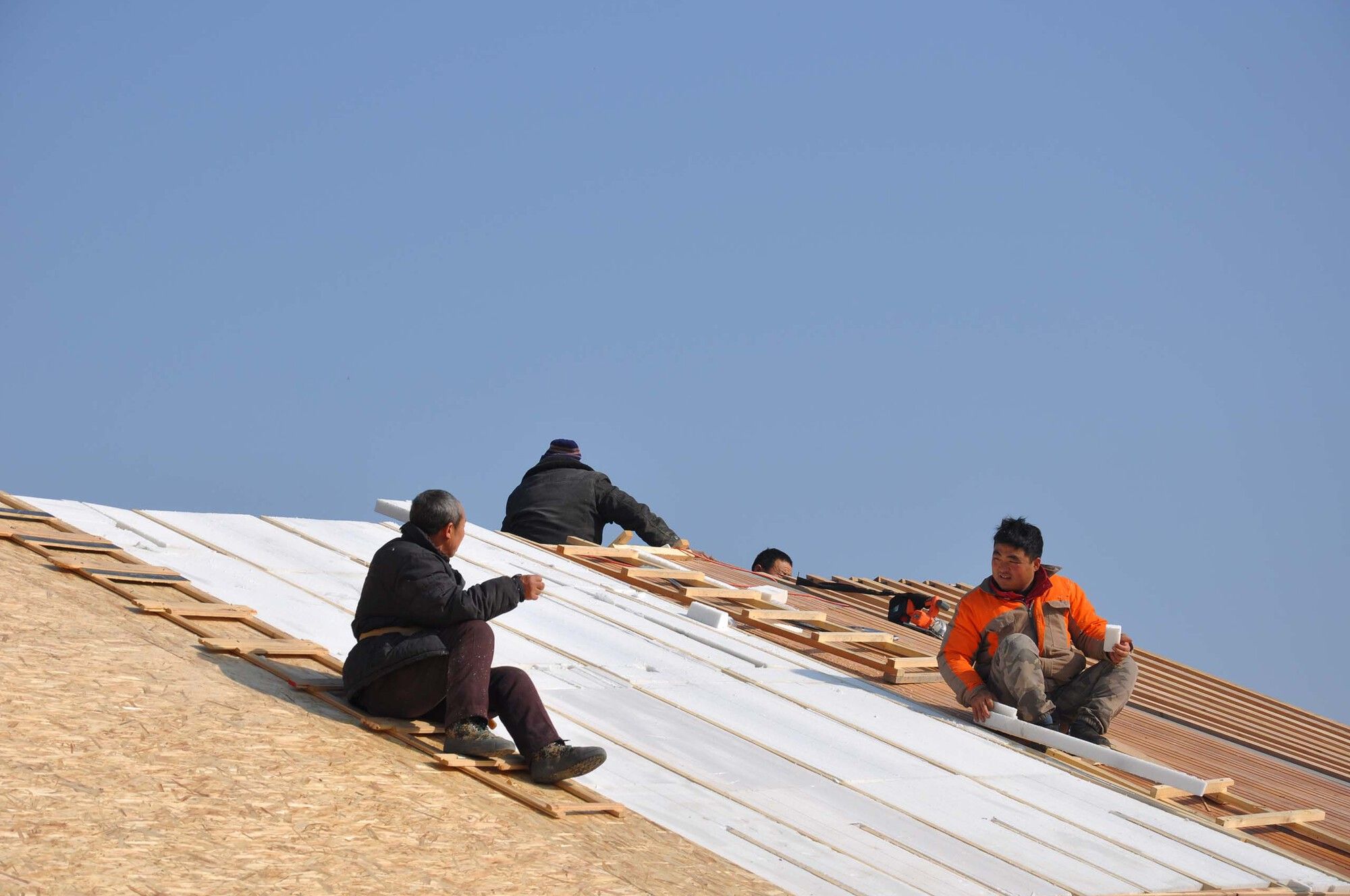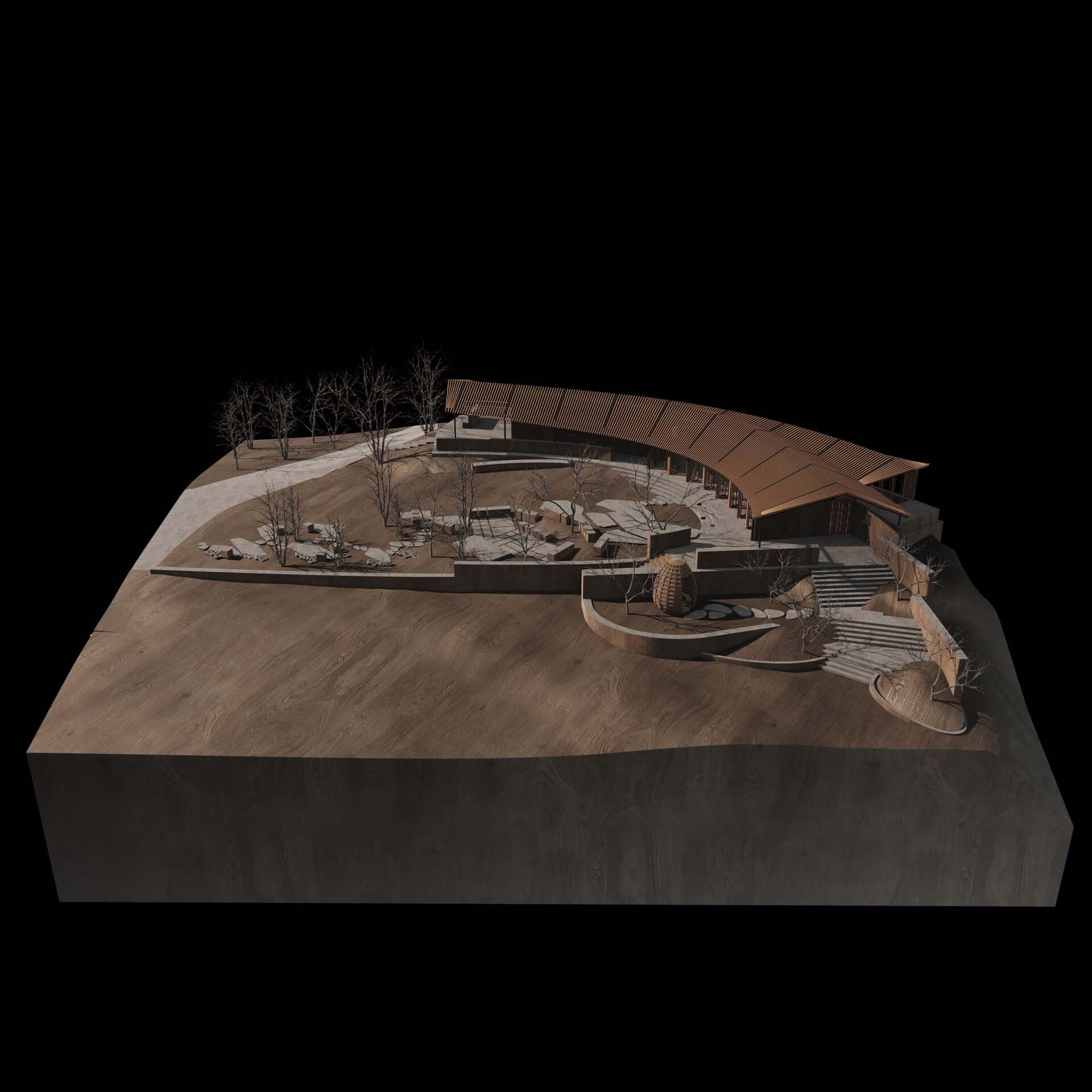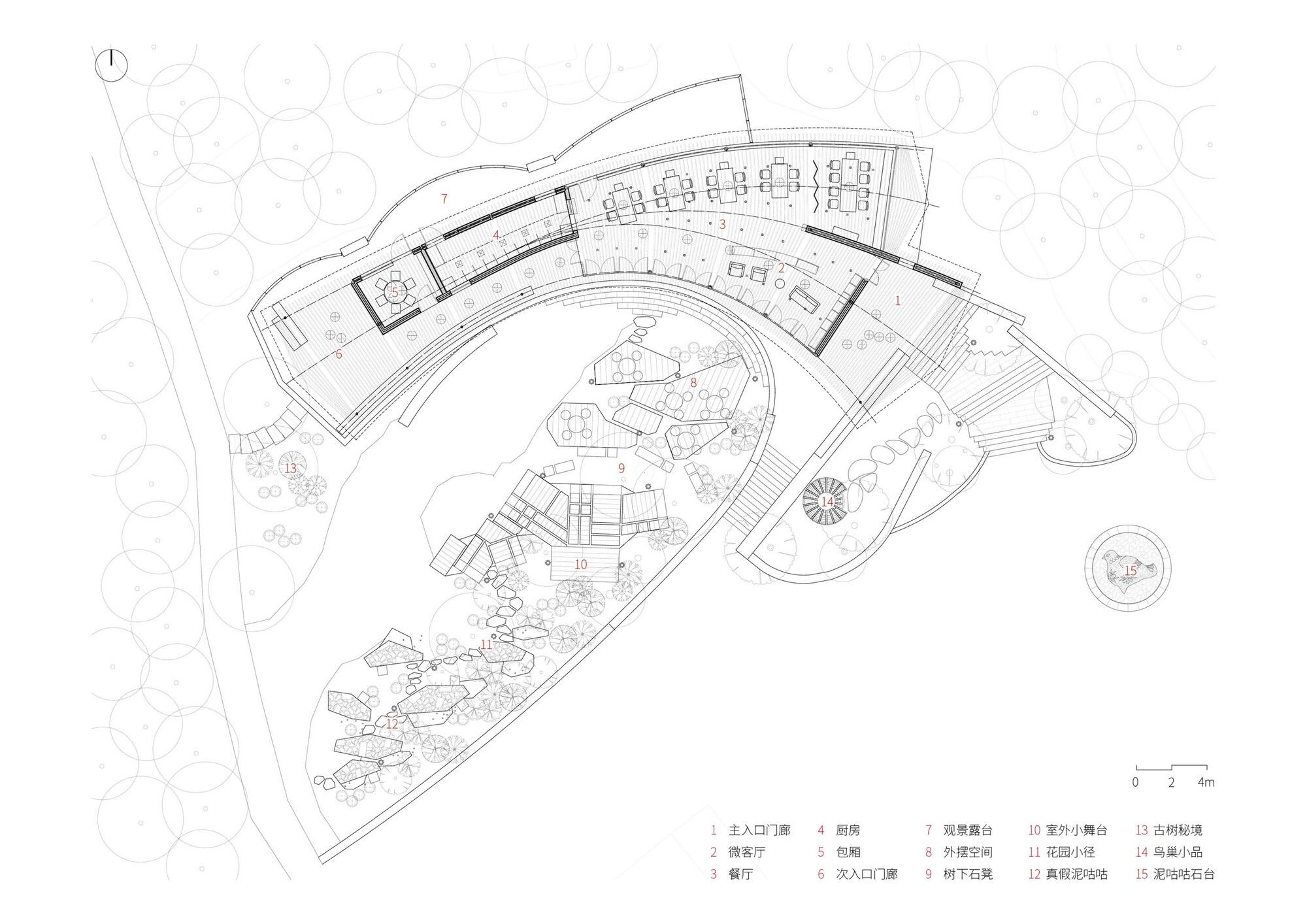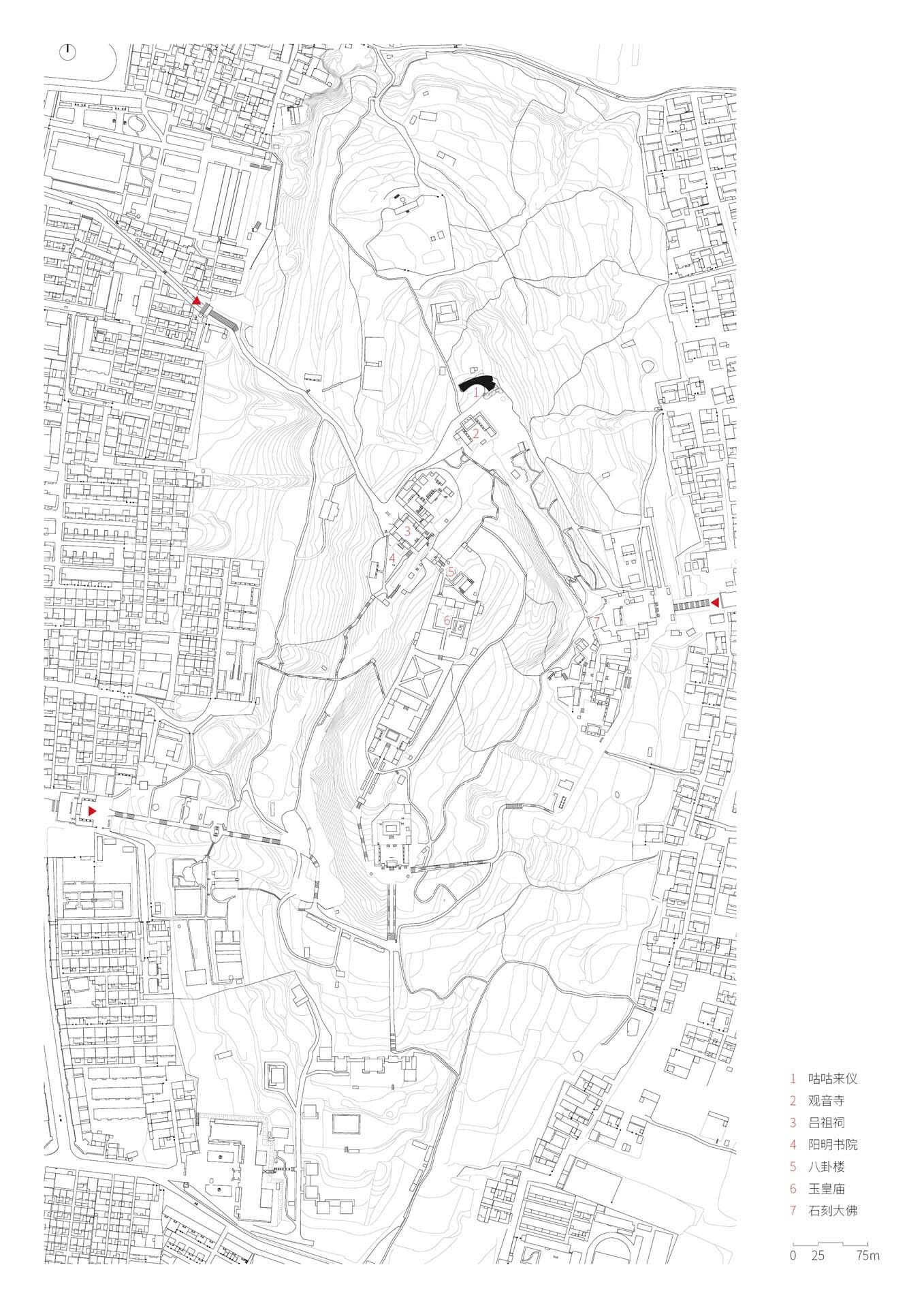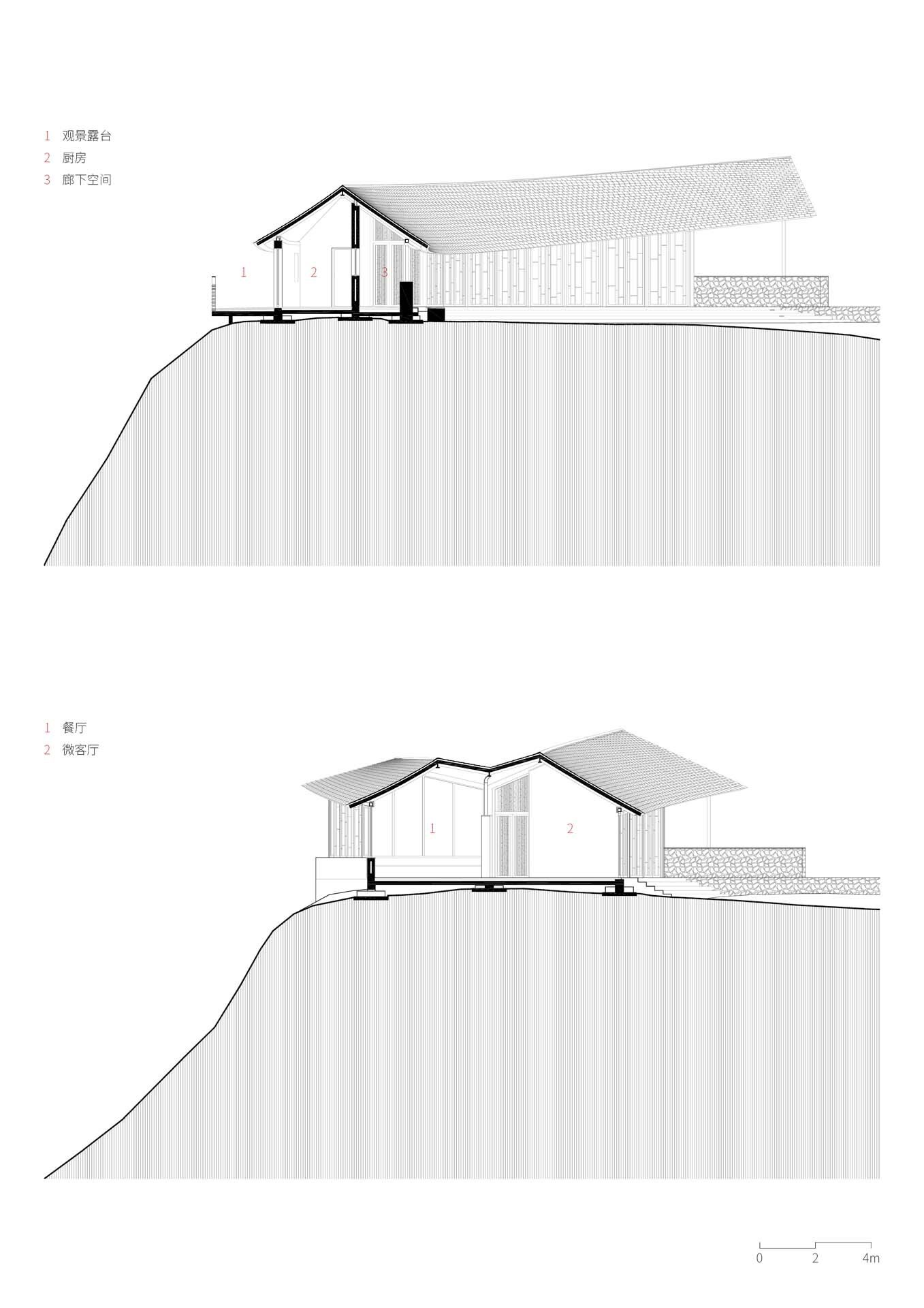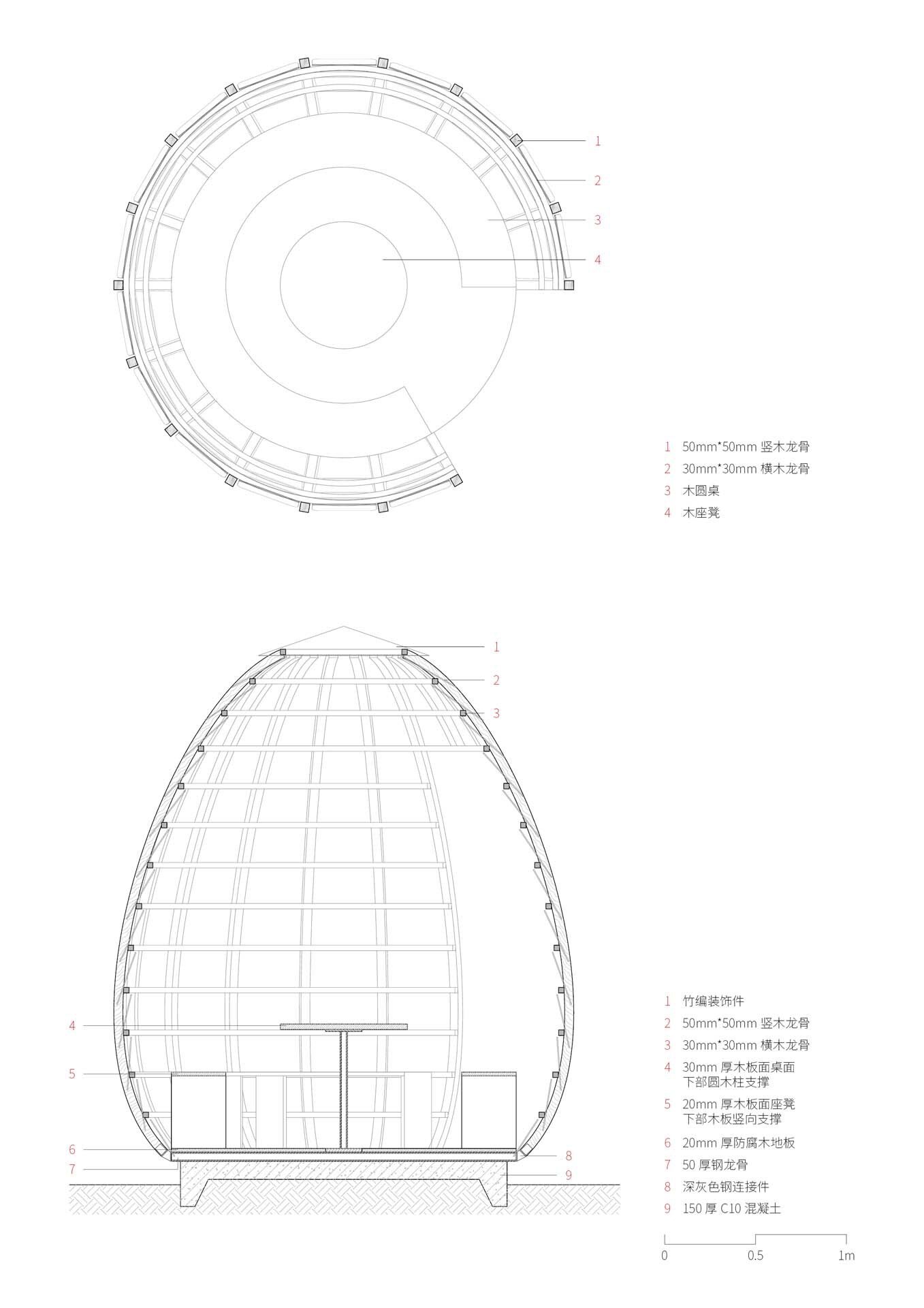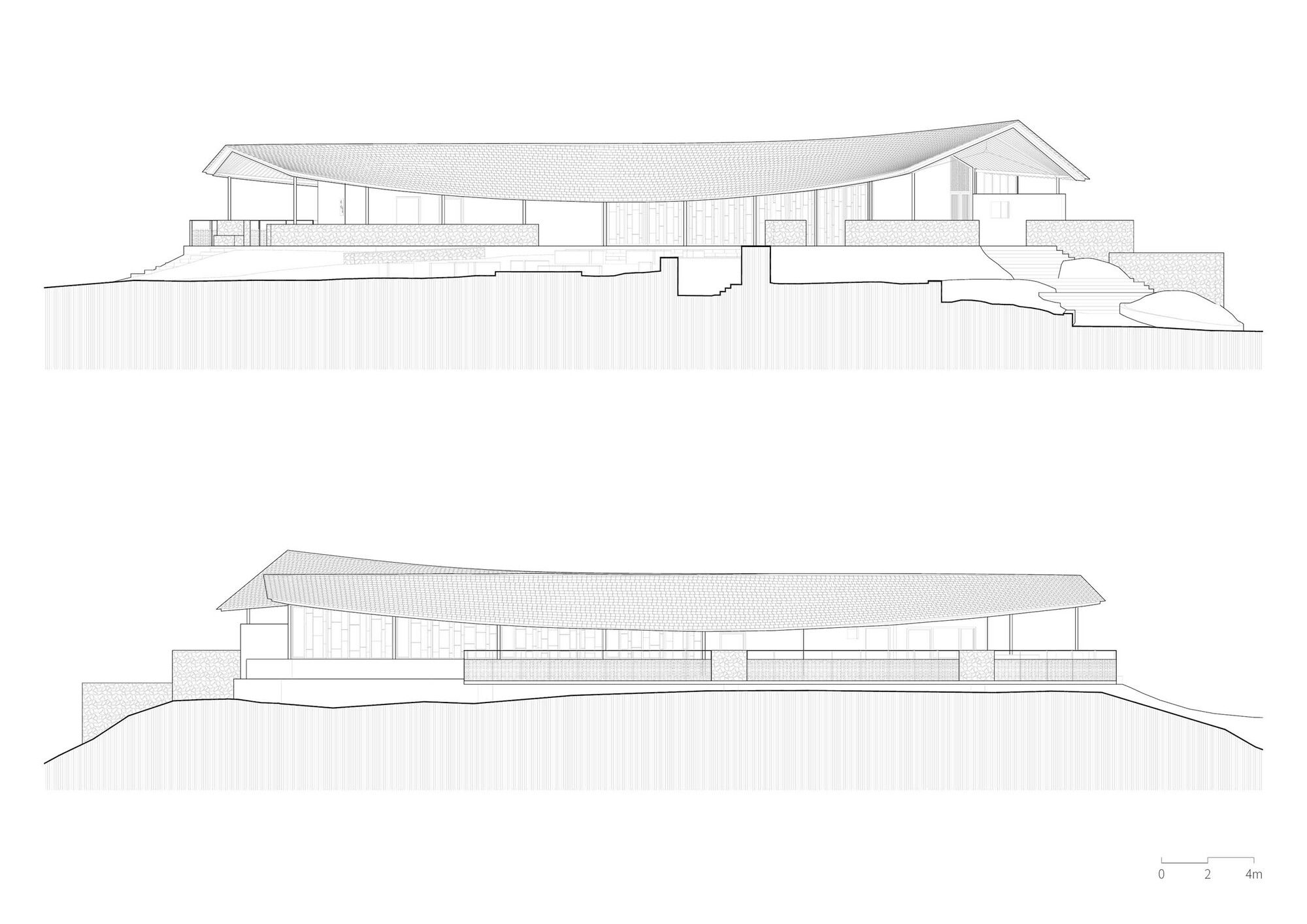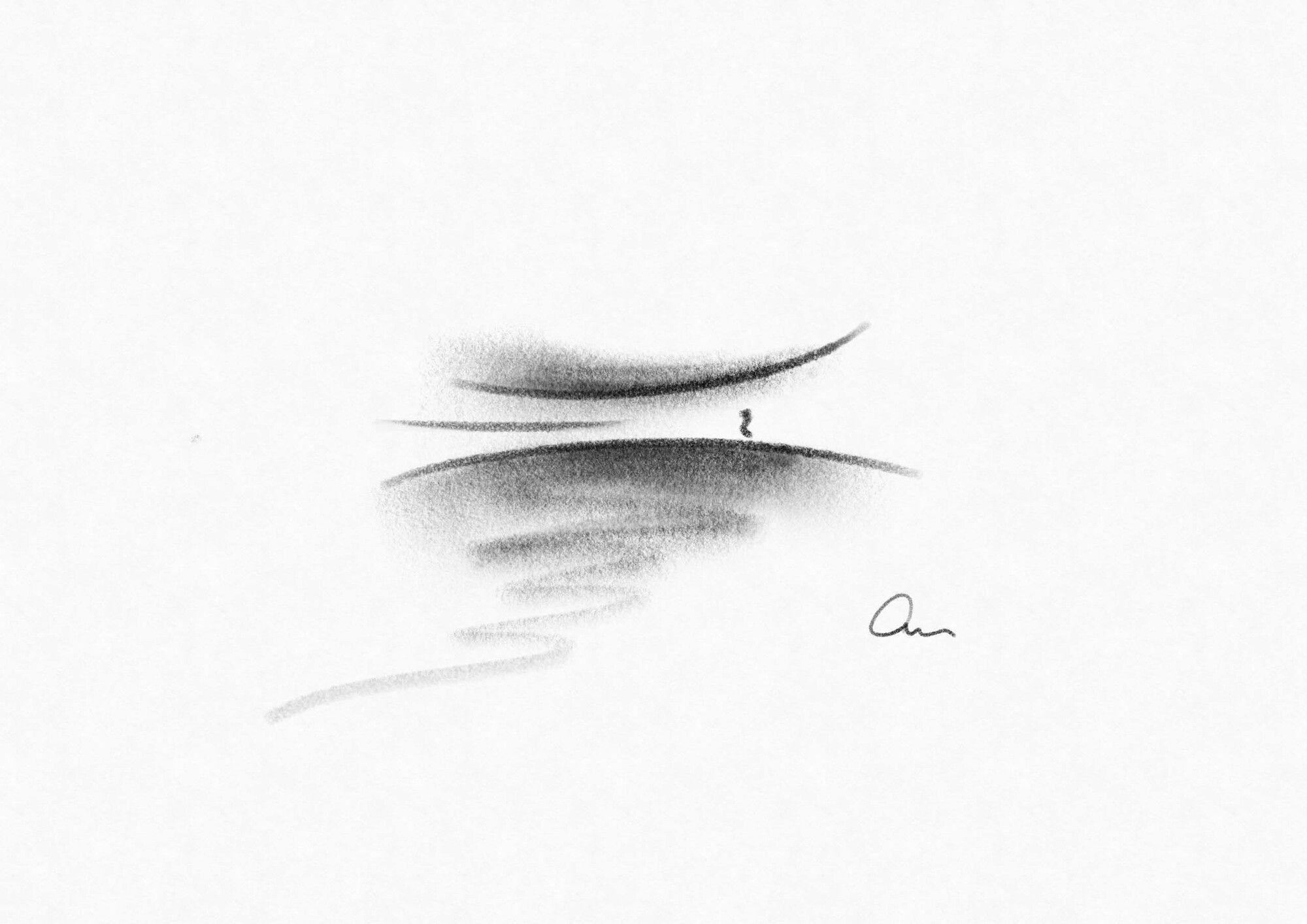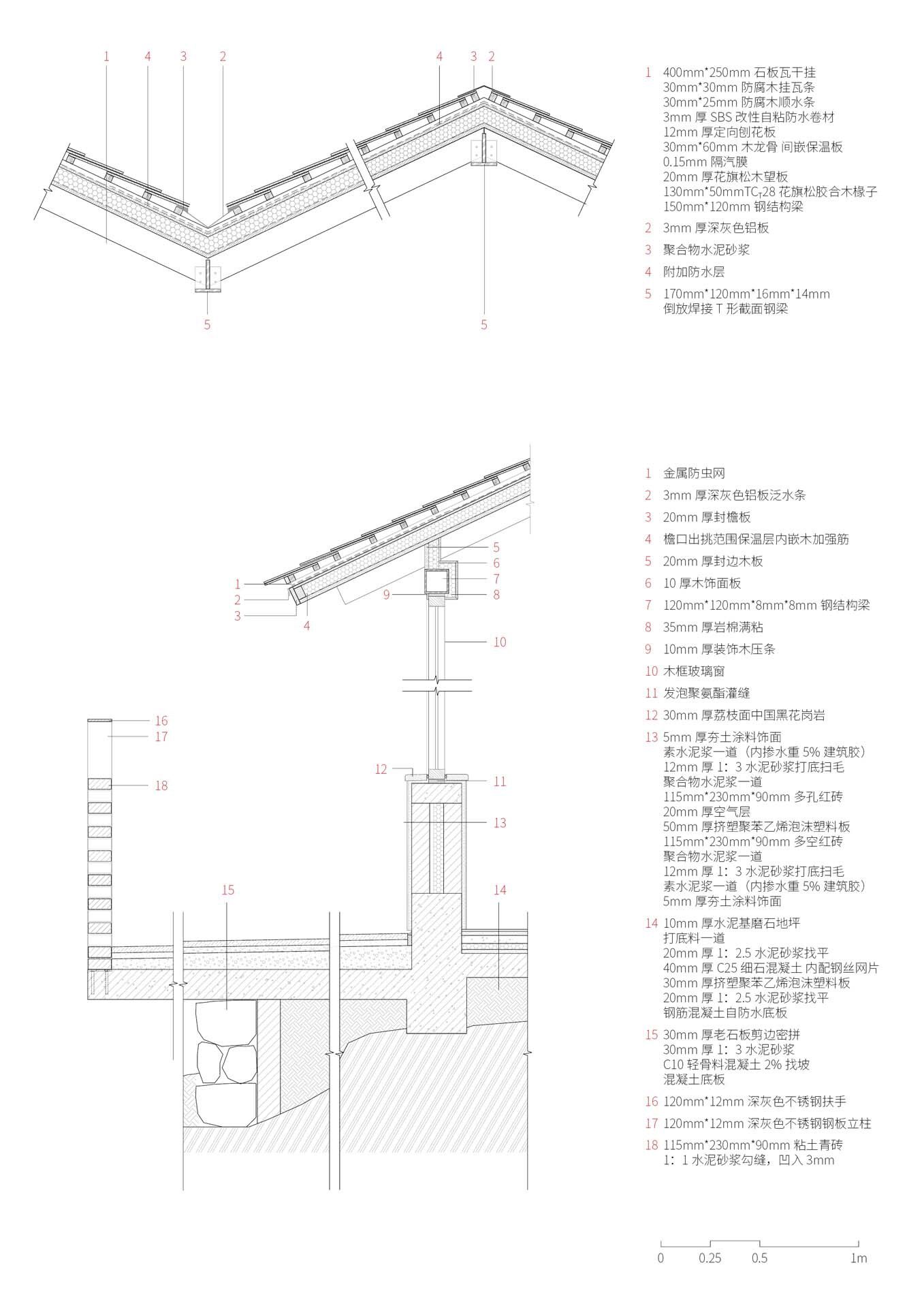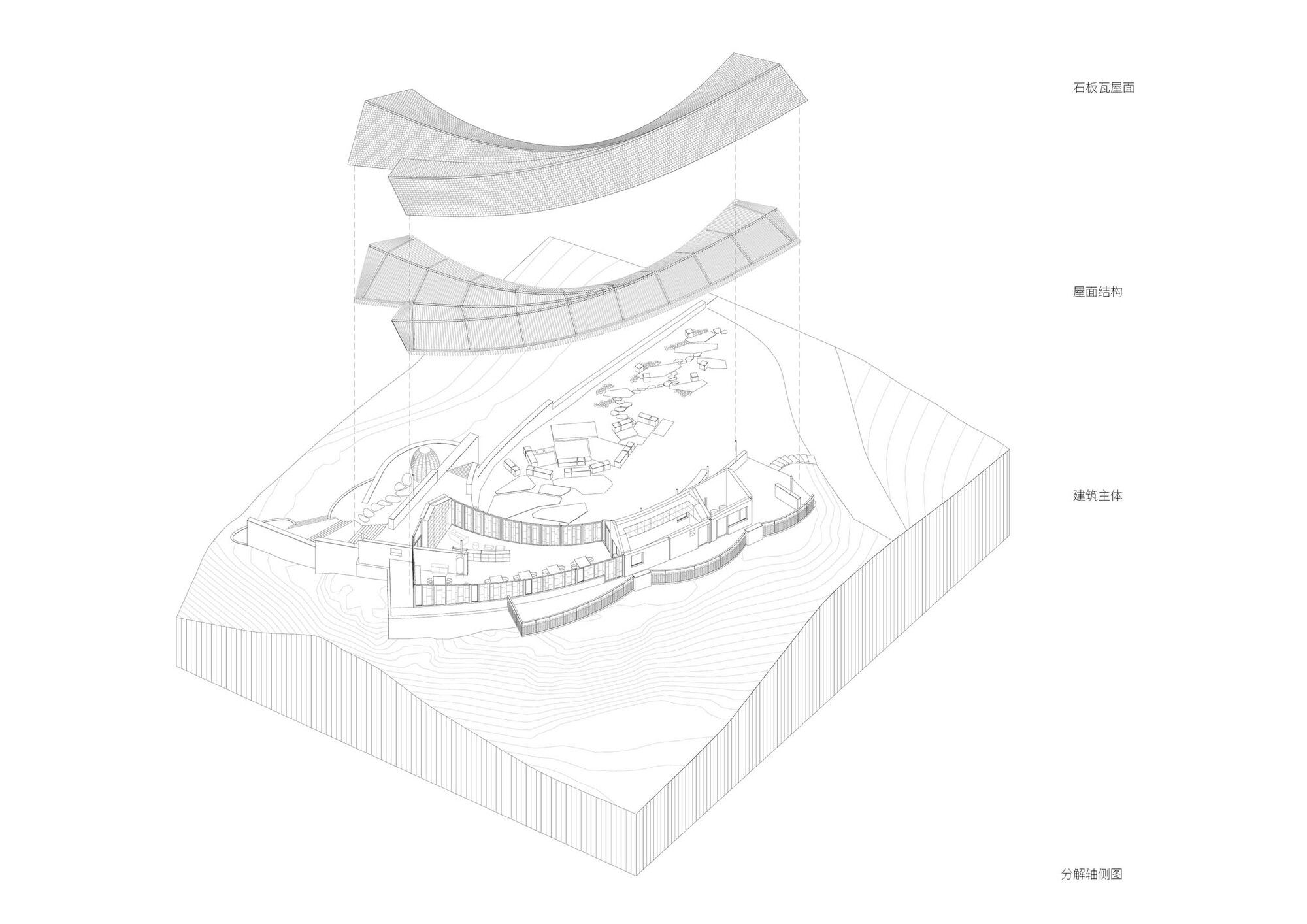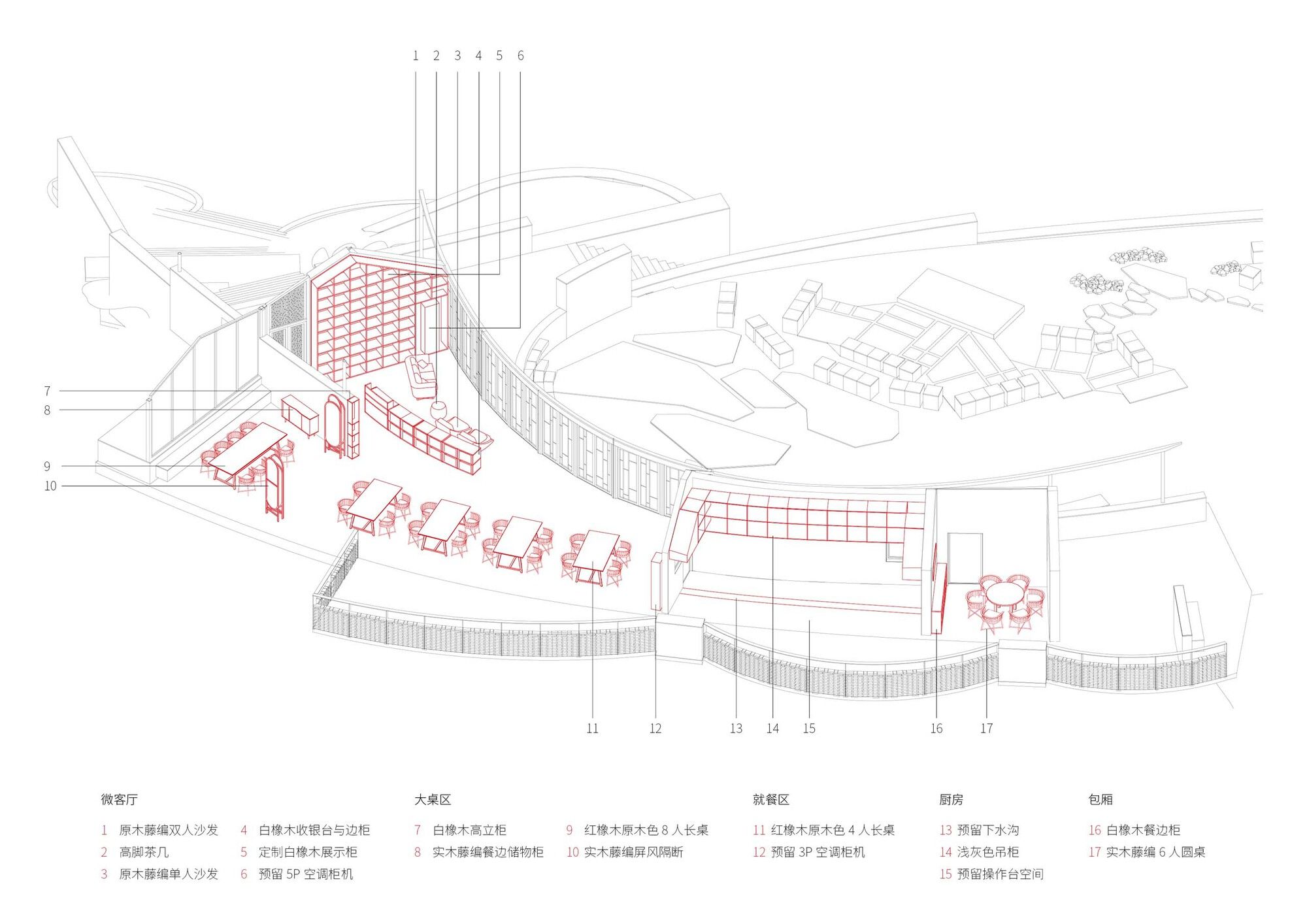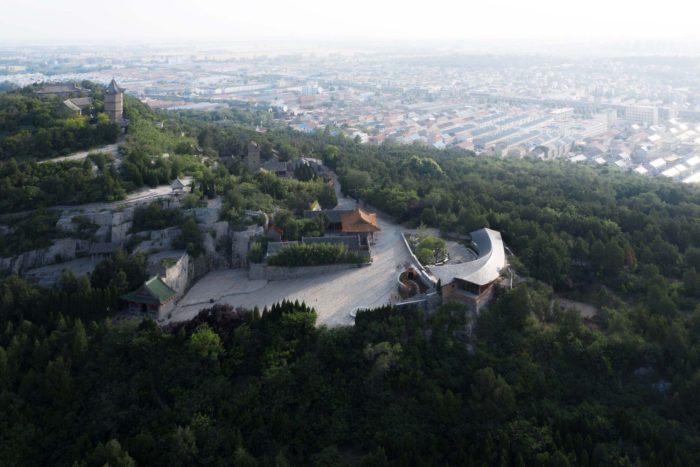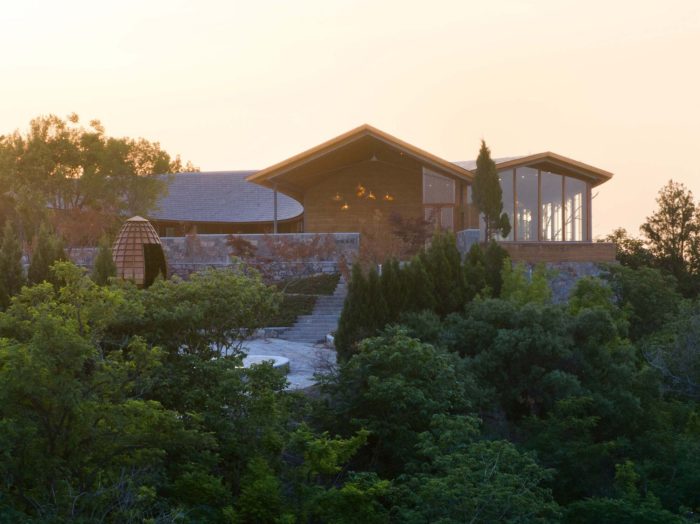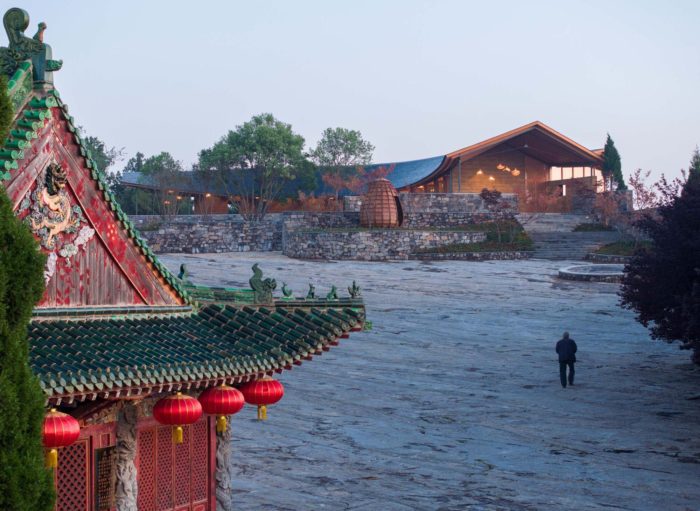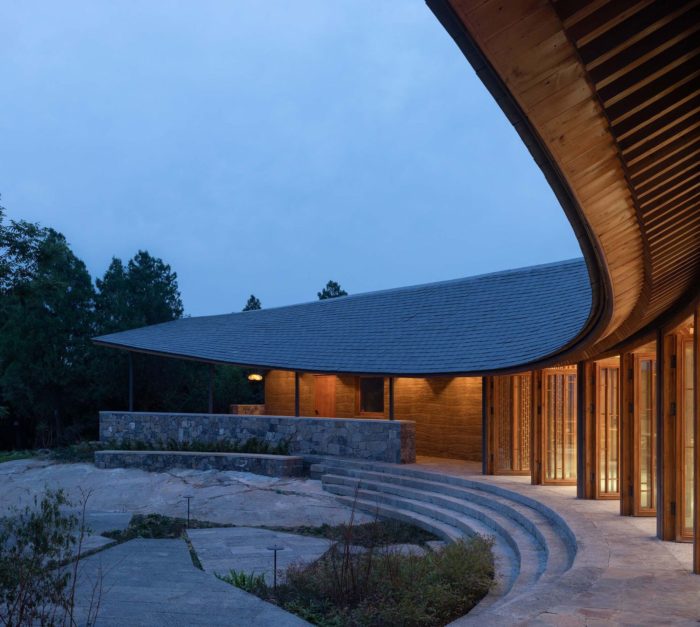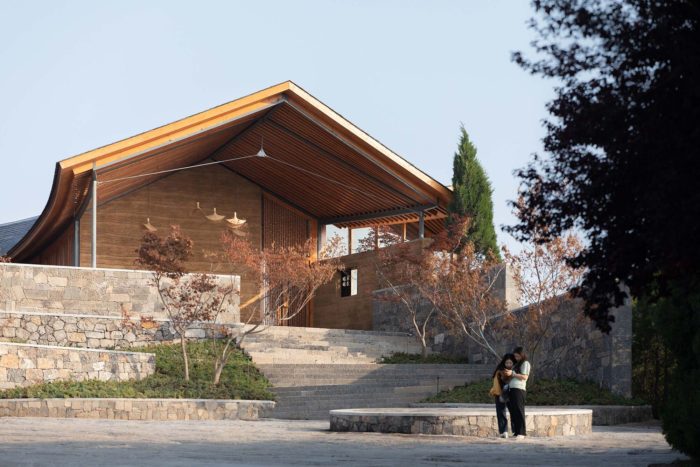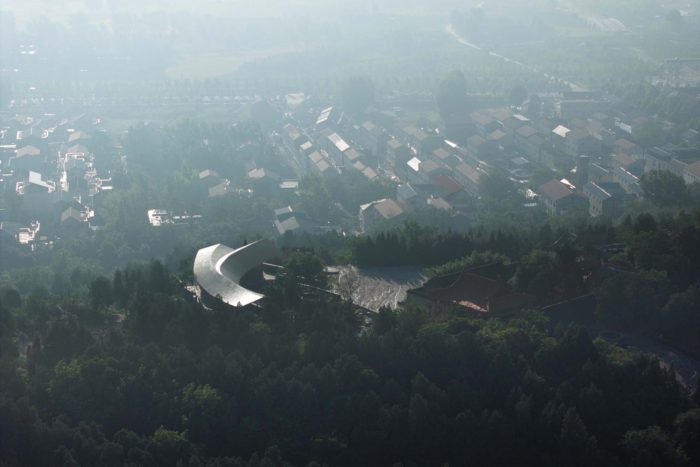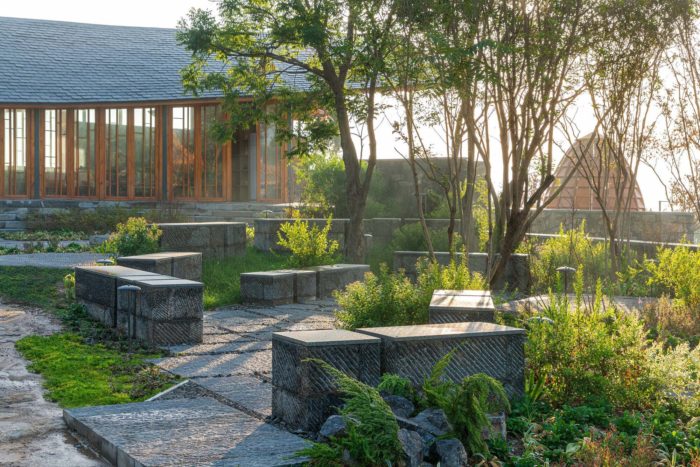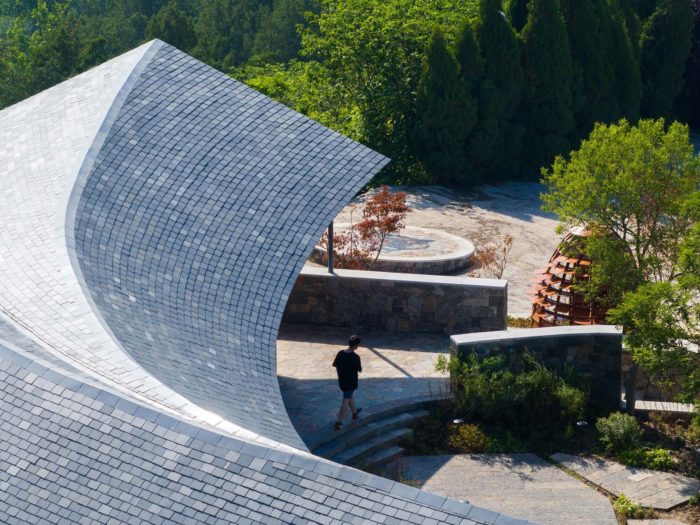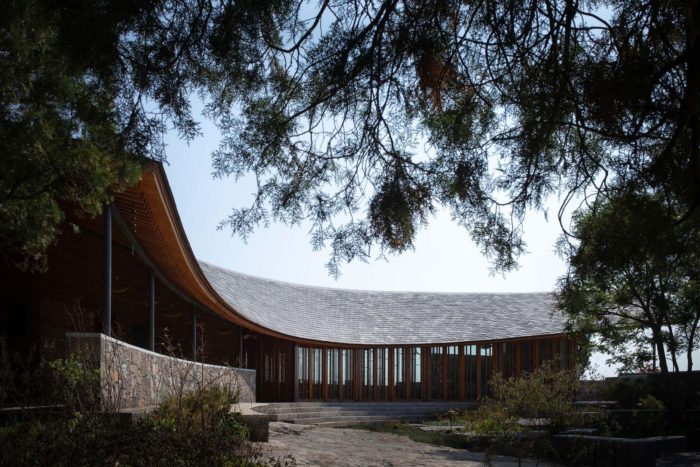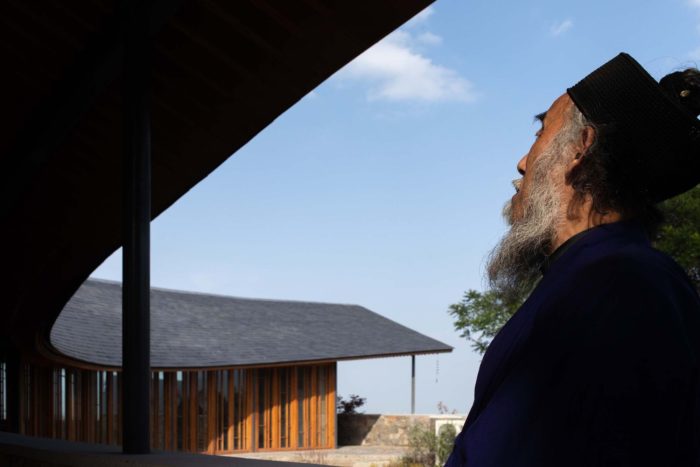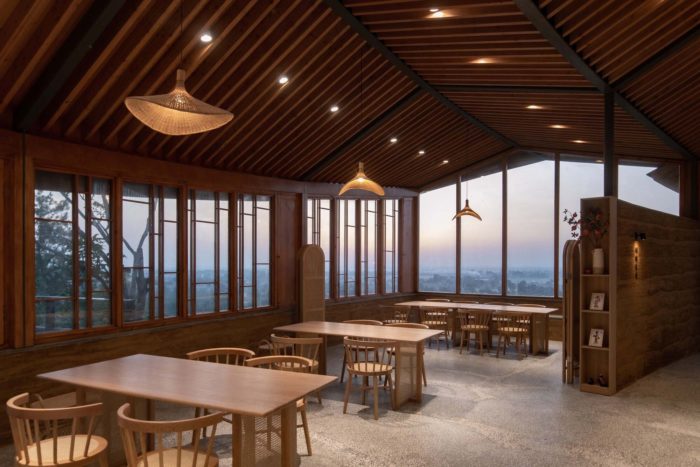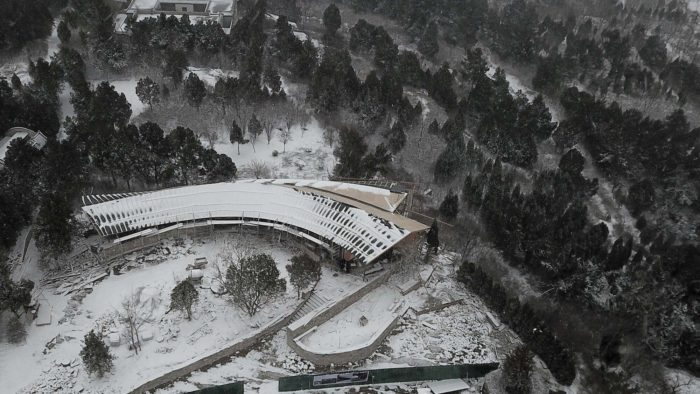About Dapi Mountain:
As we ascended Dapi Mountain for the first time, we encountered endless rocks, moss-covered grounds, guiding pine trees, and a series of ancient temples. Standing amidst the ancient temple cluster on the site, we deeply felt that the Dapi Mountain Pavilion would inevitably play a secondary role, integrating itself humbly into the millennia-old historical ambiance.
In the early summer of 2022, we were invited to participate in the ‘Heritage Illuminates Our Hometown Henan’ construction event. When thinking of Henan, vast fields of wheat, profound agricultural culture, and a deep-rooted simplicity come to mind. With a sense of awe and anticipation, we boarded a northbound train, embarking on a journey of architectural construction. Dapi Mountain is located in Xun County, Hebi City, Henan Province. It is renowned for housing the earliest and largest cliff-carved Buddha statue in China, and to the north of the Dapi Mountain lies Guanyin Temple, which dates back to 700 years ago and is surrounded by ancient cypress trees. On the first and fifteenth day of every lunar month, people flock to the mountain to pray. The Dapi Mountain Pavilion site is situated on the northern edge of the cliff, adjacent to Guanyin Temple, where an abandoned bungalow once served as a resting place for visitors. The owner wished to revitalize this location into a station, providing visitors with an enhanced experience while showcasing the local intangible cultural heritage and craftsmanship.
During our initial visit to the site, we discovered that Dapi Mountain had an actual height of 135 meters, contrary to our initial perception of towering peaks. Instead, it stood as a solitary peak rising abruptly from flat terrain. The entire Dapi Mountain was composed of grey stone, ascending in gentle steps, exuding a serene and elegant ambiance with lush greenery all around. What left a lasting impression was the presence of these natural grey stone formations. There were no artificially constructed roads near the site; instead, the landscape was dominated by the rugged appearance of the mountain itself.This naturally expressive setting filled us with anticipation for the architectural character. Standing within the site, we traversed countless thoughts, ultimately focusing on practical design challenges. How can we create a space that showcases intangible cultural heritage on this historically significant dapi mountain? How can we handle the natural changes in the mountainous terrain within the site? How can we maximize the northward views for visitors? And how can the architecture engage in a natural and understated dialogue with Dapi Mountain?
The original entrance to the site was located on the west side, relatively concealed and narrow, with only a zigzag-shaped double-sloped bungalow within the site. After analyzing the topography of the site and considering the flow of people nearby, we decided to position the main entrance on the east side, where the Dapi mountain terrain underwent dramatic changes, resulting in a height difference of approximately 2 meters. Accompanied by a well-organized staircase at the entrance, we aimed to create an architecture that would greet visitors ascending the Dapi mountain in the most exhilarating manner. The architectural layout adopted the enclosed arrangement of the original site, employing a gentle linear volume that linked the entrance spaces on the east and west sides, while also providing ample courtyard space for resting on the south side.To prevent the interior space from appearing cramped and elongated, we added a small volume in the best position for northern landscape views. It seamlessly integrated with the main structure, enhancing the visual richness of the eastern entrance, and presenting a contrasting front-back and high-low state. The junction of the volumes became particularly complex due to irregular contours, with three ridges and one valley converging at a single point. Not only did they intersect and connect with each other in terms of mathematical relationships, but they also varied in height. This approach aimed to enhance the architectural form’s diversity while ensuring proper drainage.
Ascending the steps along the main entrance, tourists walk past a grey stone wall adorned with red maple trees and enter an open rest area. On the southern side, there are continuous solid wood doors with elegant window frames that offer views of the outdoor garden courtyard. Looking out from the north-facing windows, an unobstructed mountain view stretches before us. Opening the doors leads to a terrace where they can stand, leaning against the railing, and gaze into the distance, allowing the Dapi mountain breeze to brush past. Entering the site through the secondary entrance provides a completely different experience. Passing through a path of grey stone steps amidst a grove of cypress trees, people stroll leisurely along the covered corridor.
On the left side, a richly textured curved rammed earth wall presents itself, while on the right side, there is an expansive view of the courtyard scenery and a half-height stone feature wall. As the line of sight gradually lowers, people step into the station space. The varied experience under the covered corridor diminishes the prominence of the service area on the other side of the rammed earth wall. Stepping inside the station, the furniture becomes an extension of the walls. Bookshelves, reception counters, and storage racks follow the contours of the walls, further emphasizing spatial delineation. If the roof serves as an element that brings together the design elements, the furniture acts as the structural component within the space, utilizing a unified vocabulary to depict different levels of variation. Moving from the exterior to the interior, the space transitions from enclosed to gradually transparent, slowly merging the outdoor landscape into the indoor environment.
Taking a panoramic view of the entire site, the architecture should present itself in a discreet manner within this historic mountainous landscape, resonating with the nearby ancient structures such as the Guanyin Temple and Bagua Tower. While preserving the sloping roof form of the surrounding ancient buildings, the main structure was constructed using modern construction methods to achieve a lighter architectural form. The architecture continues the language of ancient buildings with upturned eaves, gradually raising the eave heights of the eastern and western entrances to create a sense of grand entrance, while keeping the center portion as low as possible, just enough to avoid bumping heads. In contrast, the terrain of the mountain slopes gradually decreases from the center, moving in the opposite direction of the architecture, creating a noticeable tension between them. In order to better integrate the architecture into the surrounding environment, the height of the building was precisely controlled, not exceeding the height of the main gate of Guanyin Temple, presenting a humble and modest posture in front of the ancient buildings. At the same time, in the selection of building materials, many local materials were used, such as grey stone from Taihang Mountain, locally used preserved wood, rammed earth walls with a rustic atmosphere, and slate tiles to enhance the texture of the roof.
This commission was a semi-propositional task, with the owner hoping for the architecture to serve as a promotion of the local intangible cultural heritage. After carefully reviewing various local intangible cultural heritage practices, we ultimately chose “Clay Gugu” as the main theme for this project. “Clay Gugu” is a traditional clay toy that can produce a “gu gu” sound when blown into, often depicting the image of a cuckoo bird. As a handcrafted art form passed down for centuries, it not only showcases the craftsmanship of artisans but also aligns with the spirit of craftsmanship in architectural creation. We aimed to immerse people in the permeation of intangible cultural heritage throughout the entire architecture, from its overall design to the smallest experiential details. At the entrance, the stone platform features a Gugu bird, setting the thematic tone right from the start. Next to the large rammed earth wall, tourists can feel the local artisans’ mastery of shaping the clay, reminiscent of the skilled craftsmen who create the “Clay Gugu”. Within the enclosed garden courtyard, a display of authentic and replica “Clay Gugu” installations catches the eye, as if glimpsing a Gugu bird flying towards the mountaintop and gracefully perching beside the ancient temple.
It’s worth mentioning that we used slate tiles for the roof, a material that blends seamlessly with the earthy tones of the surroundings, evoking a sense of light akin to a flying bird. While there are many choices in terms of color and materials for cement tiles and ceramic tiles, with thicknesses ranging from 2 centimeters and above, slate tiles are remarkably thin, occasionally featuring slight imperfections on the edges that harmonize well with the surface of the mountain. Throughout the construction process, we repeatedly collaborated with the construction team to ensure the proper roof installation, the desired eave projection distance, and the drainage system of the gutters, aiming to maximize the coverage of the slate tiles on the roof while keeping the metal edging or gutters as minimal as possible. As the sun moves from east to west during the day, the roof tiles shimmer and reflect light, resembling the graceful feathers of a bird in motion.
Due to its location halfway up the mountain, the project posed significant challenges to structural design and construction operations. The Dapi Mountain is a geological heritage site, prohibiting deep excavation for foundations. Therefore, individual excavations were carried out for each column base, with the foundation depth calculated based on the varying rock layers. Each foundation pit was photographed, numbered, measured, and calculated on-site. After multiple adjustments and optimizations, the construction proceeded successfully. The foundation depths varied, with the shallowest being only 300mm and the deepest located on a 2m cliff edge. The entire foundation resembled a person’s fingers, working together to firmly grasp the mountain. While stationed on Dapi Mountain, we had extensive discussions with the construction team to address nearly every design aspect. These discussions ranged from the construction layers of the roof to waterproofing measures at the ridge.
We delved into detailed treatments of eaves boards and the connection structures between rafters and gate boards. From on-site secondary bending of steel structures to simulating the overlapping of slate tiles, on-site control played a crucial role in the completion of the project. Moreover, during our time on-site, we witnessed the craftsmanship and artisan spirit of local artisans. The stone craftsmanship for the stone cladding, cutting, and precise stacking of each stone in the grey stone walls, installation and production of solid wood doors and windows, and wooden tile shingles for the landscape pavilion—these processes were all carried out by them, eschewing the precision and uniformity of factory mass production in favor of the delicacy and variability of handmade craftsmanship. It is through their efforts that the building, emphasizing a sense of craftsmanship and a wild aesthetic, was ultimately completed.
The construction of the Station has been a journey that spanned an entire year, experiencing the full cycle of seasons from spring to winter. Arriving at Dapi Mountain in the midst of summer, the breathtaking beauty of the mountain scenery and the profound cultural heritage left a deep impression. As construction began, we gradually entered the harsh winter, where the challenging construction conditions reminded us of the ruggedness of nature and the delicate craftsmanship of human intervention—a contrasting yet complementary interplay of two forces. We had to respect the mountain and proceed with caution.Approaching the completion of the project, it is now the season of spring, where everything comes alive, and the building, just like the new leaves on the branches, exudes vitality. Welcoming the coming summer is a brand-new Dapi Mountain. Dapi Mountain Pavilion is an architectural work that brought together the efforts of the local government, construction team, and artisans, with many individuals investing their time and energy into it. We hope that once it is fully operational, it will serve as a cultural platform, continuously shining a light on the promotion of local intangible cultural heritage.
Project Info:
Area: 210 m²
Year: 2023
Photographs: Xiaobin Lv, Arch-Exist
Lead Architect: Xin Ji
Design Team: Xin Ji, Jiaqi Ge, Chao Chen, Ting Xi
Structure Design: Xiaotian Yang, Kunying Wu
Interior Design: Xin Ji, Jiaqi Ge
Landscape Design: Zhi Wang
Logo Design: Xin Ji, Jiaqi Ge
Vi Design: Congfei Zou, Haoxiang Chen
Engineering: Henan Zhengjue Construction Engineering Co.
Client: Xunxian Tourism Development Service Center
City: Hebi
Country: China
